“Lost Highway”—The Rules of the Road
(and I want you to study that motherf***er)
By
Owen Hammer
It is impossible to understand the film Lost Highway (1996) without understanding the complex symbolic infrastructure of the film’s “universe.” Yes, the primary purpose of people walking through holes in space, dead people returning, and time looping is to create an intense emotional reaction—mostly anxiety and wonder—using the tools of cinema. It’s true that Lynch is intuitive not empirical. He doesn’t create a set of rules for his stories, but there is an internal logic to all this, otherwise it wouldn’t be surreal, it would be random. In other words, I cannot reverse engineer Lynch’s creative process, but I can tell you what’s happening in this film.
In order to establish a foundation of current thought about the movie, let me first talk about the “common wisdom” in regard to Lost Highway. I will discuss what’s right and what’s wrong with it, and then lay out my own theory.
NOT NECESSARILY HOW IT HAPPENED | IS THE PETER a figment of Fred’s imagination?
Like most Lynch films it is classical surrealism which means that it is both baffling and compelling. There is at least a tiny fingernail grip that fans have in understanding this film—Lynch’s admission that the story was inspired by the murder of Nicole Brown and Ron Goldman by former American Football star O.J. Simpson1. Lynch has gone on record calling O.J. Simpson’s state of mind a “psychogenic fugue state” and acknowledging that Lost Highway protagonist Fred Madison (Bill Pullman) is in the same condition2.
Well, then, that’s settled! Fred murdered Renee Madison (Patricia Arquette) and then he went into a dream world where he is not only innocent, but also a completely different guy named Pete Dayton (Balthazar Getty). This “Pete is a Dream” Theory seems to be the accepted explanation for Lost Highway.
Matt Murray of Corn Pone Flicks presents the best summary of this theory in his video3. I am debunking this theory, not dunking on Murray who is an excellent film analyst. I highly recommend his work, but I do not think he is very good at explaining David Lynch films.
This Pete-is-a-Dream theory is just wrong. There are so many inconsistencies with this interpretation that it is either insufficient or completely misleading. I will go over the many pieces of evidence from the text that contradict the Pete-is-a-Dream Theory, but the big one is the scene near the end at Andy’s house where the two detectives from the “real” world reconnoiter with the two detectives from the “dream” world. Police detectives AL (John Roselius) and ED (Lou Eppolito) arrested Fred and are presumably in the real world and police detectives HANK (Carl Sundstrom) and LOU (John Solari) are following Pete so we presume that they are in the “dream” world. In fact, I initially thought that Hank and Lou were the dream counterparts to Al and Ed, and I think that this was a conscious misdirection. Murray said, in referencing the expression “throwing a monkey wrench into the works” that this scene “throws several entire boxes of tools into the works4.”
What about when Pete turns back into Fred? This is Fred waking up from the dream, right? Well then, why is he in the desert instead of his prison cell? A corollary to the Pete-is-a-Dream Theory is that these events happened earlier in the film, and that’s why Renee and Dick Laurent (Robert Loggia) are still alive. What about the Mystery Man’s presence at these events? Surely such a bizarre ghoul is a figment of Fred’s imagination, right? But Dick Laurent refers to Fred and the Mystery Man as “you guys.” Can Laurent see Fred’s hallucination or is Fred imagining that Laurent can see the Mystery Man? If yes to the latter, then why do we assume that Laurent is even there or that any of this is real? You see the problem.
Let’s give ourselves permission to ignore that and place the events in chronological order. Renee is wearing the dress she has at Andy’s party, so she goes home and waits for Fred to take her to the party. Fred kills Laurent, goes home, hides the Mercedes Benz, changes clothing after explaining to Renee why he was wearing a black leather jacket, takes Renee to the party, comes home, waits for Renee to fall asleep, goes back to the party, kills Andy, goes back home, kills Renee (if we assume that this is all one night), puts the leather jacket back on, leaves the house and collects Dick Laurent’s car, wherever it may be, and goes back to his house so he can tell . . . somebody? . . . that Dick Laurent is dead.
In Lynch’s Mulholland Drive (2001) there is a clear demarcation between the dream world and the “real” world—a rare display of charity from Lynch. There is no scene in Lost Highway that is plainly “real” and therefore no way to interpret a “dream” sequence as a commentary on the dreamer’s mental state. Unreliable Narrator is one thing, but Indecipherable Narrator does not make for a good story.
The problem with arbitrarily demarcating fantasy and reality is that we give ourselves permission to dismiss mysteries that “don’t count.” We can’t forget that the whole movie is “not real.” Let’s take a look at the scene where Fred is in prison and he sees a hole open up in space that takes the shape of curtains opening, and he sees another place—a desert—and a shack inside which he sees THE MYSTERY MAN (Robert Blake). Like most of the movie, the image gives us a sense of anxiety and wonder. It is utterly fantastical. Fred doesn’t know what’s happening and we don’t know what’s happening, so, in a way, we are locked in the cell.
It is tempting to say that this is Fred’s imagination, but we are not required to assume that. Who says that a hole in space can’t open up? This is a movie. Let’s figure out what’s going on here.
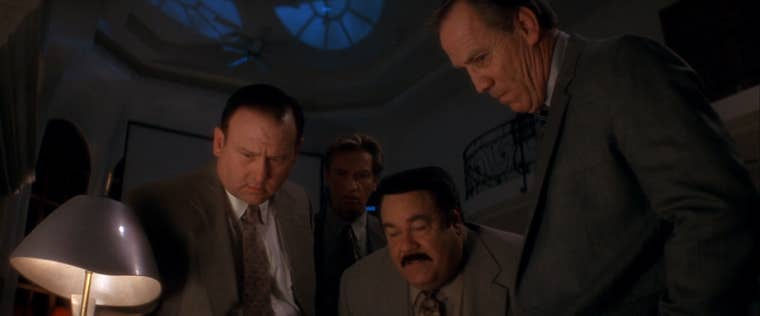
Police detectives Al and Ed are supposed to be “real” while police detectives Hank and Lou are supposed to be their counterparts in the dream world. Their presence in one scene is Lynch’s way of saying, “not so fast!”
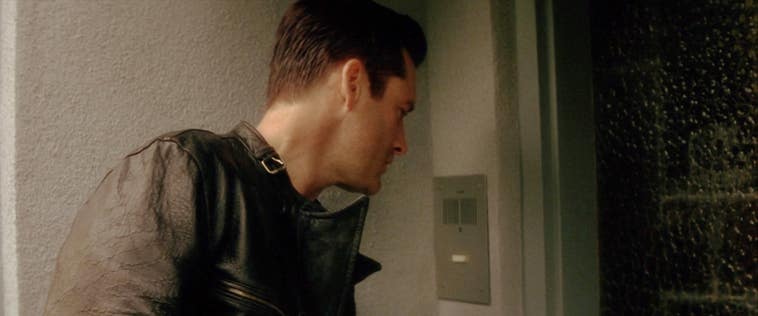
“Dick Laurent is dead . . .and after twenty-four hours of running around in this leather jacket, I’m about the die.”
Out-uglying the sumbitches | Is Lost Highway Lynch’s commentary on film itself?
A film series called “placereel” has posted a video5 that points out similarities between David Lynch’s work and Oliver Stone’s work and also similarities between Lynch’s later work and those same Oliver Stone projects. Placereel claims that Lynch is stealing from the stealers and calling out plagiarism.
They note that Stone’s Wild Palms TV miniseries in 1993 has similarities to David Lynch’s seminal Twin Peaks (1990-1991) and Stone’s film Natural Born Killers (1994) is almost the same story as Lynch’s Wild at Heart (1990). Additionally, there are scenes from Lost Highway that seem to lift ideas and visuals from Palms and Killers. But here’s the big one, Robert Loggia and Balthazar Getty play characters that are almost identical to their characters from Palms and Killers respectively. Did Lynch cast these parts in order to comment on Stone’s alleged plagiarism?
My first thought was, “well, no, obviously.” Casting is such an important decision and financiers that out-rank the director are involved. Then I realized that placereel had ignored something—Quentin Tarantino. Tarantino has also been accused of plagiarizing from Lynch. Tarantino wrote the screenplay for Natural Born Killers, and Tarantino also wrote the screenplay for the Tony Scott-directed True Romance (1993), which also has strong similarities to Wild at Heart6. The leading lady in True Romance is Patricia Arquette who plays a similar character in Lost Highway. I believe that we have crossed some kind of probability threshold and we can say that this is not a coincidence. Lynch is definitely making a statement with his casting choices.
Friend, collaborator and fellow film-maker Jeffrey Williams also accepts the theory that Lynch is making a commentary with his casting choices because all casting choices are comments on the actors’ prior work. “Filmmakers and producers [are] absolutely aware of actors’ work in other prominent films, it’s unavoidable. And actors . . . often are cast specifically to bring that energy to a new work.”
Lost Highway was written during a dark time in Lynch’s life, a time after his film Twin Peaks: Fire Walk with Me (1992) bombed and almost destroyed his career. At this same time, rising star director Quentin Tarantino went so far as to attack Lynch.
After I saw Twin Peaks: Fire Walk with Me at Cannes, David Lynch had disappeared so far up his own ass that I have no desire to see another David Lynch movie until I hear something different. And you know, I loved him. I loved him.7
I will try to avoid psychoanalyzing Lynch, but it’s not a stretch to assume that this enraged him, even if “enraged” to the mild-mannered Lynch is a slight shrug of the shoulders as he drinks a Bob’s Big Boy milkshake.
When Dick Laurent is being tailgated and he tailgates the tailgater, placereel interprets this as Lynch being plagiarized and then plagiarizing the plagiarizers. I think placereel is partially correct, but isn’t it weird to think that Dick Laurent is supposed to represent David Lynch? Lynch often does self inserts, most famously his Twin Peaks character of Regional Director and later Deputy Director GORDON COLE is him, the director, appearing as the director. It seems very strange that Lynch would have a vicious mafioso represent him. I will address this contradiction later.
Placereel’s theory is true but insufficient. There is much more going on in Lost Highway. But keep Tarantino and Stone in the back of your mind. Like the time loop in the movie, we will come back to this.
In their video8 “Matt” and “Craig” from the Welcome to the Basement series describe the movie as a self-referential film in which the process of filmmaking is examined. When Fred turns into Pete, they speculate that the protagonist is being abandoned by the filmmaker-within-the-film and replaced. Again, they have discovered a few things that are true, but they also have an incomplete theory.
So that’s where the common wisdom is when I began this essay. Now let us begin the task of examining the many metaphors and developing a complete theory. Let’s start with the most obvious metaphor . . .
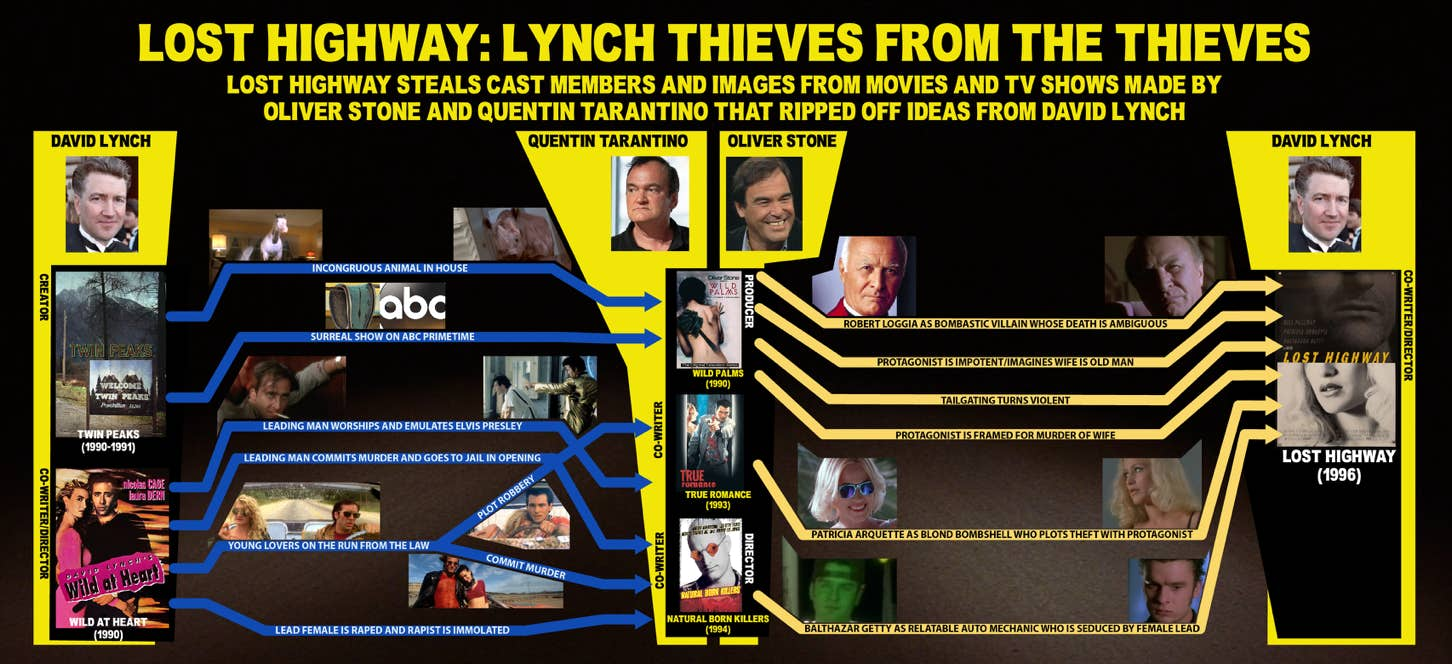
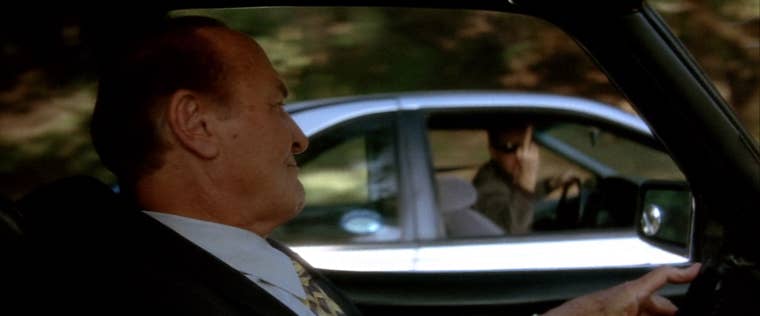
The Tailgater gives Mr. Eddy the finger. Is this how Lynch perceives of fellow film-makers who dissed him?
EPONYMOUS | What is the two-lane desert road we keep seeing?
At five times in the movie, we see a dark, two lane desert highway at night. This is THE “Lost Highway” of the film’s title. It leads to the “Lost Highway Hotel” so it’s not cavalier to assume that such a place would be on “The Lost Highway9.”
Think about the actual, physical film running through a projector bulb. If we move the observer to the inside of the projector and change the angle of the light, it kind of looks like a dark highway. Now, let’s imagine that there are two bulbs and two strips of film parallel to each other to mimic the two eyes of a human. The sprocket holes will form a series of dashes that rush by us, just like the lines on a highway. “Lost Highway,” the highway, is Lost Highway, the film.
If the highway is black that means that the film is black and we are observing the film from this vantage point when the audience in the theater is seeing blackness. Usually credits are words on black, and so the opening credits are seen against this highway image. We see the credits literally fly at us just like the successive still images of the credits would appear to move towards us from this orthogonal viewpoint10.
After the opening credits, the picture fades to black for ten seconds. That’s a very long time to hold on black. However, we are dissolving from a metaphorical presentation of a black screen to a literal black screen, and I think the long stretch of darkness exists to let us know that we are not merely transitioning to the movie beginning but transitioning to a new metaphysical space.
Just as different roads run parallel to each other, different movies can run parallel to each other. A “Lynch Cinematic Universe?” Well, nothing so grandiose, but as we get to know Pete we find that he has a complex backstory as if there has been a “Pete Movie” running parallel to the “Fred Movie.”
The second time we see the Lost Highway is when Fred Madison transforms into Pete. The car zips down the highway and stops to illuminate Pete who is just standing there on the side of the road. If it seems like the car is “choosing” Pete. That’s no accident. The movie is selecting a new protagonist.
All of the theories about Pete being a dream are rationalizations designed to explain why the protagonist changes after the first act. They are unnecessary if we assume that the film itself has sufficient agency to do this.
So where did Pete come from? Well, he appears to be in front of what we will later learn to be his house with his father BILL DAYTON (Gary Busey), his mother Candace Dayton (Lucy Butler) and his girlfriend SHEILA (Natasha Gregson Wagner). However, he is not there. It looks like he is there, but his image is superimposed over the image of the other characters and the house.
Note that about halfway through the shot, the camera movements of the two layers in the composite are different enough that we can see that they are two shots and therefore we can see that Pete is not in the same space as the other characters. He is with us. We accept that Pete is in our film and this appears to cause him to split off of this other movie and enter our movie.
The scene is frightening because the characters are helpless, and we feel an empathic helplessness because we don’t know what’s going on. Now, I do know what’s going on, and scene is even more frightening.
The third time we see the titular Lost Highway is when ALICE WAKEFIELD (Patricia Arquette) and Pete drive the stolen red Ford Mustang to the Mystery Man’s house. The characters have left their world and entered a very different place. The first time we see the Mystery Man’s shack is through the “hole” in space in Fred’s cell. It is a metaphysically distant place, like another dimension, but there is a physical way to get there—The Lost Highway.
The next and fourth time we see the highway is when Fred drives the red Mustang to the Lost Highway Hotel. This puts the Mystery Man’s shack and the Hotel in the “other” place. This is confirmed by an earlier scene. The most jarring example of the “magic portal” is when Pete goes to the second floor of Andy’s house and finds himself in a hotel that we will later learn to be the Lost Highway Hotel. We can now start to understand the lines of demarcation.
So, we have the world of the movie—Los Angeles—and this otherworldly space east of the city of Angels in the Mojave Desert. It’s not unusual for mystical realms to be in a desert, so Lynch isn’t re-writing the Western canon, here.
What does this this framing device tell us about Fred? Fred is not just the protagonist, but he represents protagonists in general. Fred has no existence outside of the movie Lost Highway and that’s why he seems to flash into existence at the beginning and flash out of existence at the end. In the first scene, Fred is sitting in darkness as light slowly reveals him. Who’s turning on all those lights? There’s no one else in the house. It is not the light that is coming into existence but Fred himself.
In the end of the movie, Fred disintegrates. This effect is similar to the effect where Fred becomes Pete, so it has been speculated that Fred is transforming again. Also, Fred was sentenced to die in the electric chair, so maybe this is him dying in the “real” world and ending a dream. Well, both are kind of true.
Fred is sentenced to death, but how do you kill a character in a film? The electric chair shuts off the flow of electricity to the brain and when a film ends, the electricity to the projector is shut off. Fred has been sentenced to have his story end. This is why he appears to be being electrocuted when he turns into Pete, because Fred is effectively dead if he stops being the main character of the film. Since Pete transforms back into Fred, the annihilation is reversed. However, when the movie ends (assuming that Lynch isn’t planning any sequels), there is no survival for Fred and he disintegrates. Note that cause and effect are reversed again. The movie doesn’t end because Fred is annihilated, Fred is annihilated because the movie ends.
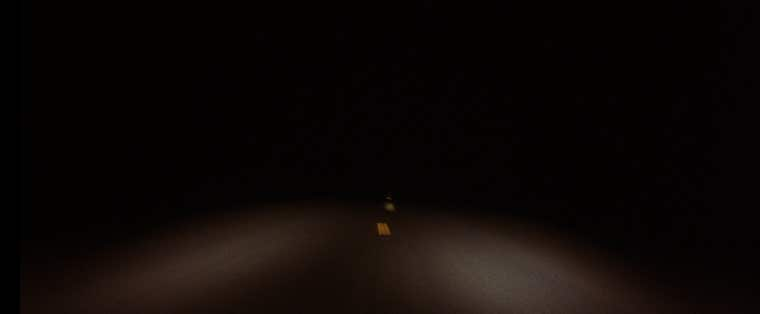
The eponymous Lost Highway evokes film going through a projector’s light—our clue that the film is about film.
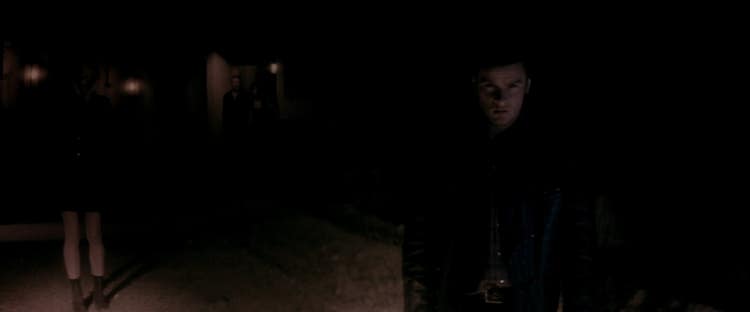
It appears that Pete is in a different scene and therefore a different movie. At first glance, Pete is in the same scene as Sheila.
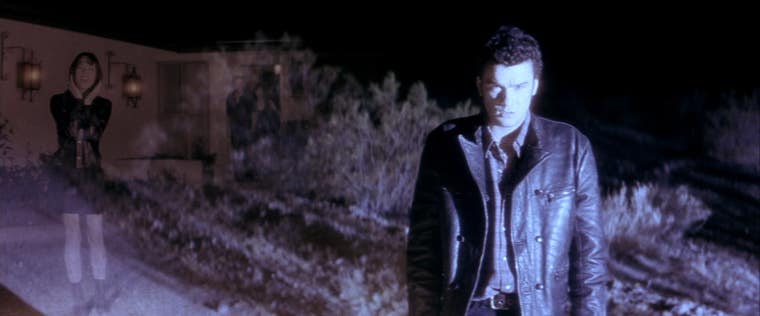
We can soon see that Pete is in a different location than Sheila as it becomes clear that the two characters are on two strips of film super imposed over each other.
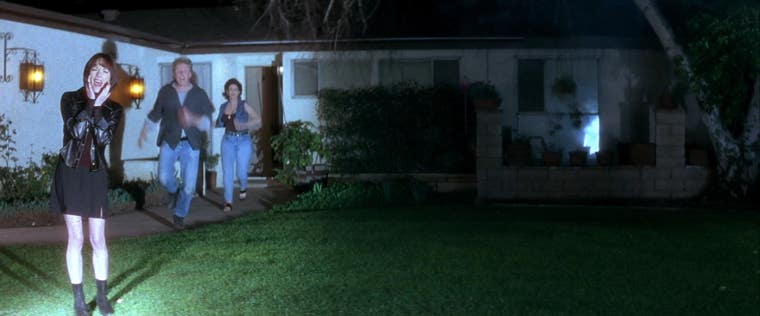
Later, we see the “B” layer of the composite by itself and understand that, from Sheila’s point of view, Pete is gone.
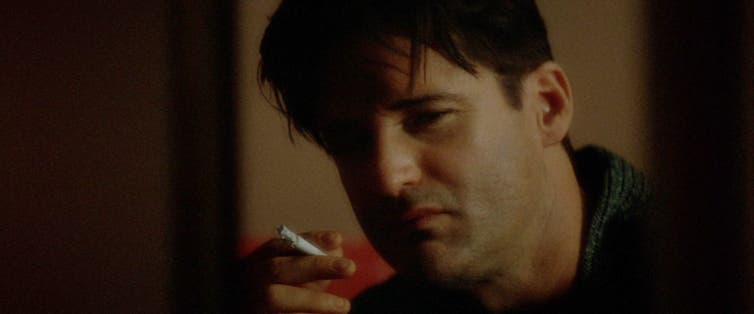
We are seeing Fred be created when light dawns on him. Where is the light coming from? “Lights, Camera Action."
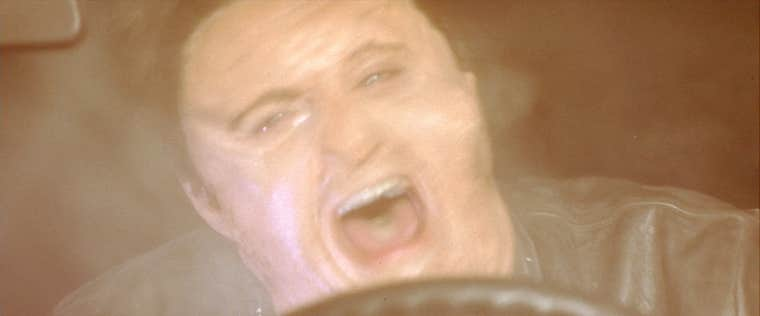
Fred meets his end, not concurrent with the end of the movie, but because the movie is ending.
THE MAN BEHIND THE CURTAIN | Who is the Mystery Man and why does he seem to have magic powers?
So what is this otherworldly place where we can find the Mystery Man’s shack and the spooky hotel? Remember, there is an animation of curtains opening when the portal is opened from Fred’s cell to the Mystery Man’s shack. The curtain animation tells us everything we need to know. If we think of the characters as being on a stage even though they’re in a film, the curtain leads to backstage and all the people and things that make a movie can be found here. In other words, the “fantasy” realm in the desert is the real world and the “real” world in Tinsel Town in the fantasy.
The other world is outside of the story or diegesis. I try to avoid Latin words I learned in film school, but it is the official and correct term for this. The story takes place on a metaphorical stage that is the diegesis and the Mystery Man’s shack and the Lost Highway Hotel are outside the diegesis. For now, let’s think of the Mystery Man as broadly representing the people outside the diegesis, including the film crew. The diegesis incorporates all of Los Angeles, where most American films are made, and the Mojave Desert outside the diegesis is outside of Los Angeles, accessible by dusty two-lane roads exactly like the Lost Highway.
Let me pause here to remind you that I am explaining the film and not trying to reconstruct Lynch’s process. In other words, Lynch doesn’t have a notebook with the word “diegesis” written down a hundred times. I’m explaining the film using the only words I can.
Why does backstage appear as a shack on stilts? I believe that Lynch is making a reference to the film Kiss Me Deadly (1955) which ends with a similar but bigger beach house catching on fire. Given the surreal nature of the film, it is possible to interpret the beach house as being in a separate metaphysical space from the other locations. I’m not proffering an explanation for Kiss Me Deadly. I’m just saying that this could easily be Lynch’s interpretation.
Additionally, the Mystery Man’s house has a chair and couch, just like the Red Room in Twin Peaks which is supposed to represent the “backstage” of the television series. The Mystery Man is quite similar to the Dwarf (Michael J. Anderson). “Backstage” is a limbo filled with nefarious and distorted characters.
So why does the Mystery Man appear so strange? With black clothes, a white face, slicked-back hair and no eyebrows, he is a blank slate. We can’t deduce anything about him. If you’re the character in a film and you saw the filmmakers, what would you think of them? You wouldn’t know what they are, where they came from or even how to put their existence into any meaningful context. You’d see a “Mystery Man.”
This is why so many things in Lost Highway are weird, we are seeing “reality” from the point of view of characters who do not know that they are unreal. This isn’t complete fantasy. Oftentimes normal things seem very strange to us because we don’t understand them. I mean, we can’t even begin to understand them. They are uncanny. Like all of his films, Lynch is drawing us into the movie by reminding us of the terror and wonder, the helplessness and freedom we feel in these situations.
But why do mysterious things happen inside the diegesis? Simple, the boundary between the two worlds is being broken.
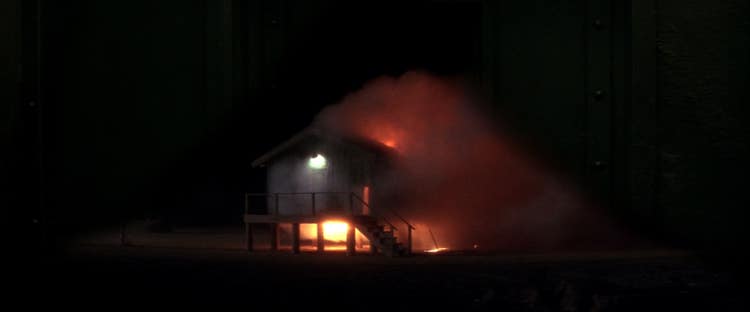
The “curtains” open to reveal the “backstage” of Lost Highway. The fire is in reverse, indicating that the shack is being created and not destroyed.
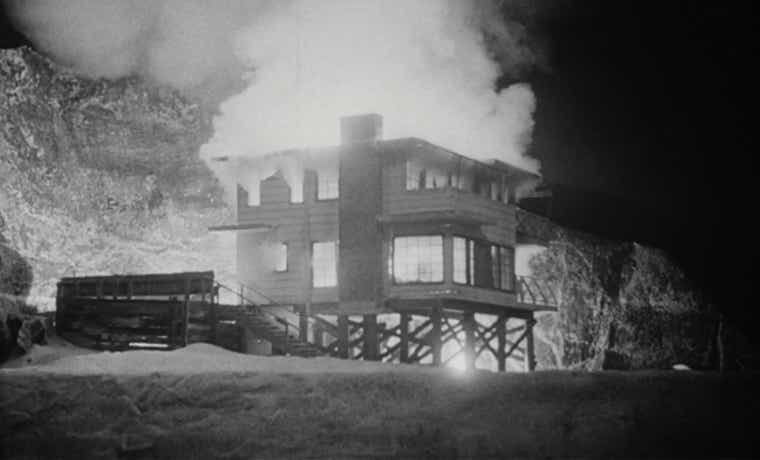
The ending to Robert Aldrich’s Kiss Me Deadly (1955). Is the apocalyptic beach house reconstituting itself for Lynch’s film?
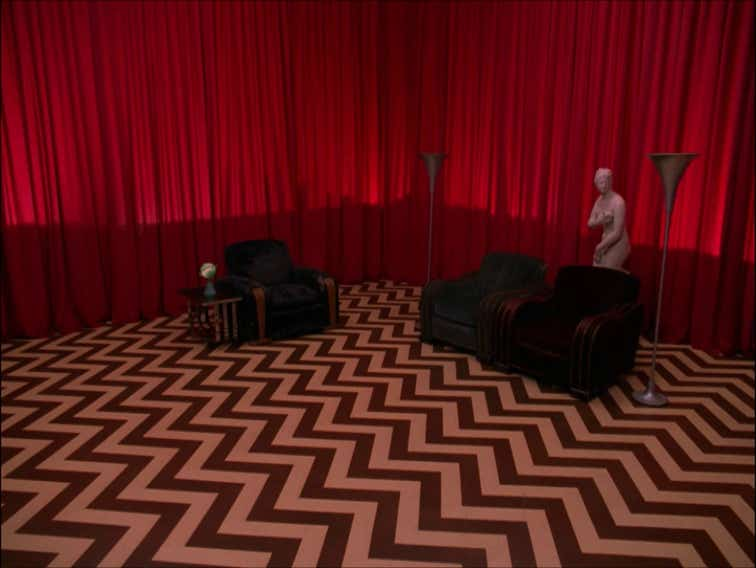
The “Red Room” from Twin Peaks which represents the “backstage” of the TV show
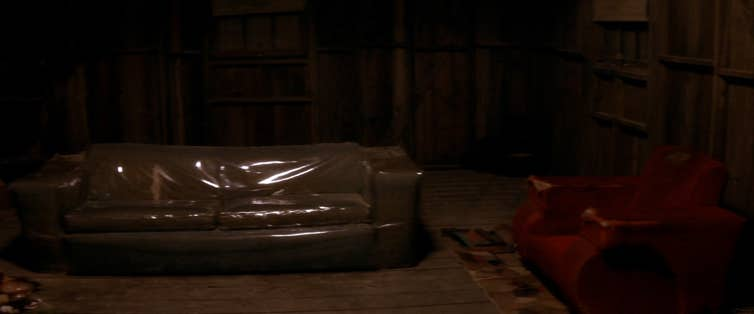
The Mystery Man’s shack appears to be a run-down version of Red Room.
“Give Me Back My Phone” | Who are the intruders in the Madison House?
There are multiple examples of trespassers in the Madison House, even though locked doors and alarms would make their presence a physical impossibility. The real-life people who make movies have access to the “Fred Movie,” and even though a fictional character would be unaware of the artifice of their reality, Fred is seeing the film crew.
•Someone turns on the lights in the first scene. Who would do that? Why, the lighting crew of course.
•When Fred and Renee Madison return from the party we can see people in the house moving lights around. They are not unintentionally moving the lights around while performing some nefarious act, they are specifically moving the lights around. They are the lighting crew.
•Someone was in the house filming Fred and Renee. Of course they were. That’s what the film crew would do.
•We see the shadow of two people on the night of the murder. Those are two members of the crew.
•The Mystery Man can not only enter the Madison House at will but he can be there and in another location at the same time. How does one bilocate? If one represents, not a person, but a group of people, it’s no problem.
If the crew has access to the diegesis, then the videotapes make sense. If you look at the images on the tape, most of them are scenes from the film. According to the script, they were all supposed to be scenes from the movie. Fred, a character in a movie, is receiving videotape dubs of scenes from the movie that he is in.
This is more explicit in the shooting script. Al and Ed, the police officers called in when the second videotape arrives, notice something that most filmmakers in the audience noticed—the images on the videotape are professionally made. The camera movements are too smooth to be a handheld camera and when the camera goes up high, it’s too high. The intruder would need a crane—the exact one used to shoot the real movie Lost Highway. In fact, the camera is supposed to be so high that the height of the ceiling would prohibit such a move11. To a character in the film who doesn’t know that they’re a character in a film, this would be “some spooky shit.”
We also have an explanation for the scene where Fred looks straight into the camera and is scared senseless, as if he sees an intruder. He is seeing the camera.
In a later scene he looks into the camera again, and walks down the hallway. However, first he looks directly into the camera, and then there is a cut to a continuous shot where he looks at something off-screen. The film has cut from a first person perspective to a third person perspective so that the camera can become a character in the movie.
Fred walks down the darkened hallway. It’s rare for a character to walk from the light into complete blackness. But Fred wasn’t supposed to walk down the hallway. The character is now doing what he wants instead of what he is supposed to do. Call “supposed to do” the script, the story, the will of the film or Fred’s destiny, but Fred is disobeying the film. When he walks down the hall, he’s committing the ultimate act of rebellion: he’s walking out of the movie.
This is one of the most iconic shots in the movie. We feel a sense of danger and a sense of exhilaration—exactly what we feel in real life when we are doing something risky of our own volition. You may have felt like Fred is moving into a very different place, a different dimension, a space where his very nature will be altered. You were right!
Let’s assume that the Madison House is a set. If no character walks down the hall in the scene, the crew might not even attach the connecting piece—the living room. Think of it this way, if an actor walked off the set, instead of being in the Madison House, and therefore in the diegesis, they would be at the craft services table or video village or whatever. But if the character has no external life as an actor, then he has essentially walked through a magic portal.
Fred does not emerge from the darkness into the living room, but rather he finds a mirror. Is this a comment on duality? Is Fred confronting his true self? Is he splitting into two Freds, one of whom is a murderer? All of these things are possible, but the important thing is that the mirror isn’t supposed to be there. Fred is surprised to see the mirror. So where is Fred? He is in a dressing room.
If this seems like a leap, remember that Pete encounters the same mirror. Surely Pete didn’t walk twenty miles to the Madison House and stumble up to a mirror. Pete has also exited the diegesis and he is just as troubled as Fred by the mystery. The first thing that Pete notices is that his head wound—the laceration on his forehead and the swelling around his eye—is gone12. Well, of course it’s gone. In the diegesis it’s swollen and bruised flesh. It takes time to heal. In the dressing room, it’s make-up.
The reverse of this phenomenon happens. Renee removes her make-up in the bathroom mirror and afterwards she still has make-up on. She cannot remove the make-up in the diegesis if it was applied outside the diegesis, which it was, by the make-up artist for the film.
Do we ever see that mirror again? It’s very dark, but it appears to be the same mirror in room 26 of the Lost Highway Hotel. The Lost Highway Hotel represents the studio where Lost Highway the movie is being shot.
This is why Pete goes upstairs at Andy’s House and finds himself in the hotel. Just like Fred wasn’t supposed to walk down the dark hallway, Pete wasn’t supposed to go upstairs. Pete has broken character. If he wasn’t supposed to go upstairs, he would wander out of the diegesis and find himself in the studio. Note that the farthest exit is a red curtain13.
Remember, surrealism is not weirdness for its own sake. Effective realism has a consistent internal logic. Classical surrealism is compelling, randomness is alienating.
So, a lot of the bizarre events in Lost Highway can be explained as the protagonist discovering that he is a character in a film and responding to this knowledge with fear, confusion and, ultimately, violence. But is there another over-arching metaphor for film sewn into the fabric of Lost Highway? Yes, there is, and it explains why Pete, our replacement protagonist, is a mechanic. He has to fix this broken movie.
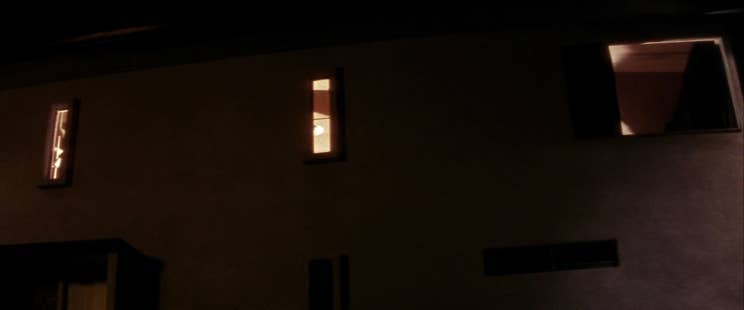
The lights indicate people in the Madison house. However, what Fred is seeing is the film crew moving the lights on purpose, not intruders moving them on accident
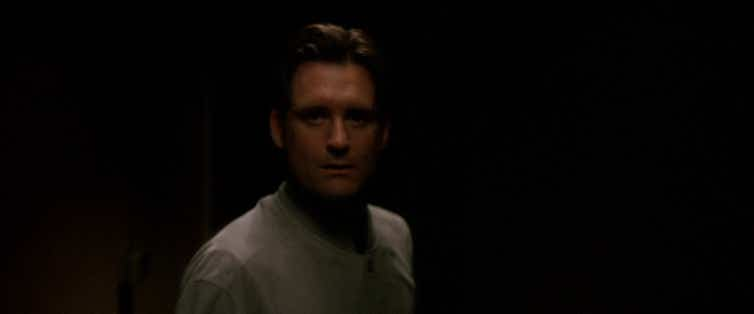
Fred sees the camera. This is the shot really gives away the store in my opinion.
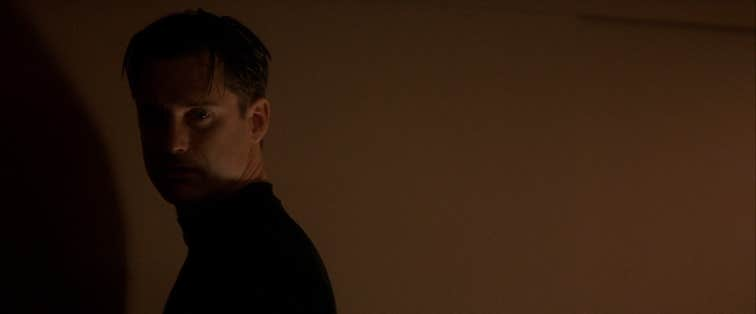
Later that night, Fred sees the camera again.
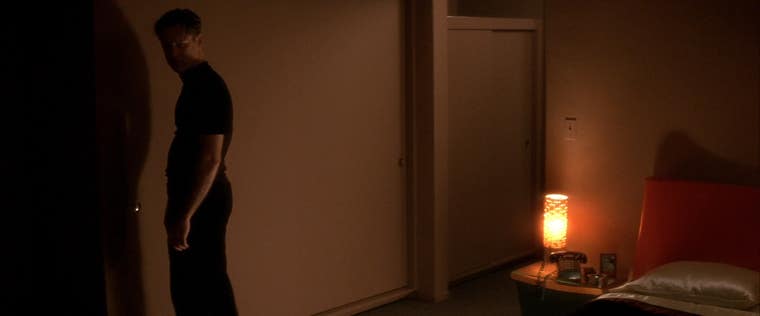
In the very next shot, Fred is still looking at where the camera was. He cannot see the second camera which observes him following someone or something down the hallway.
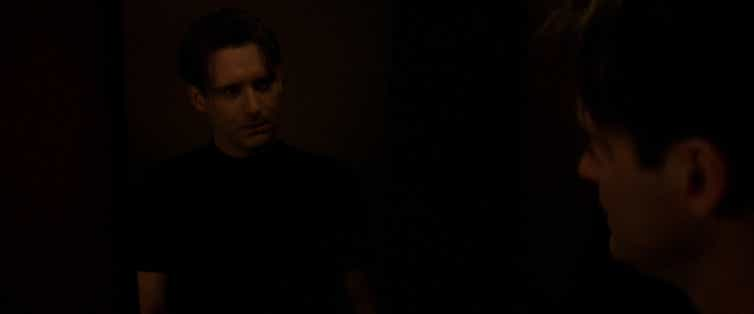
Fred sees himself in a mirror. He has left the movie and emerged in the dressing room.
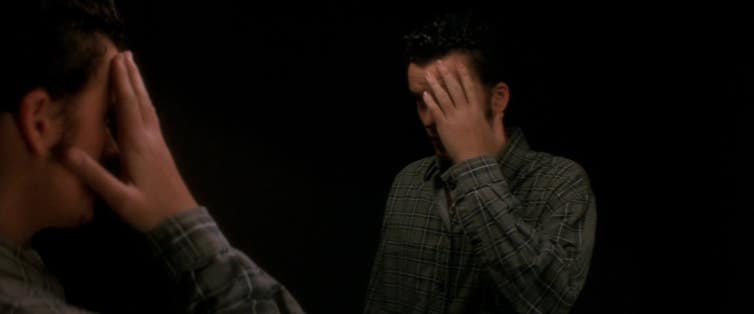
Pete finds himself at the same mirror, indicating that the mirror is not in the diegesis.
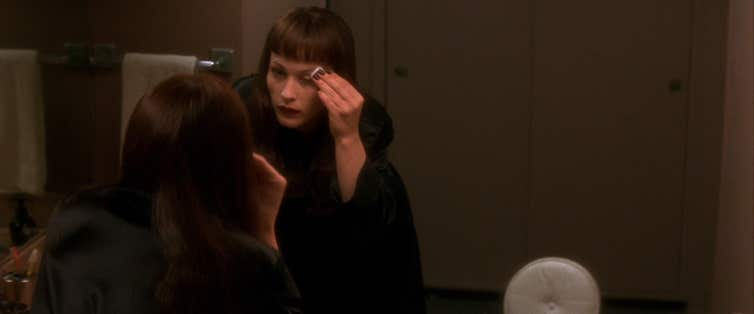
Renee uses the mirror in the bathroom to remove her make-up. However, this mirror is in the diegesis, so after removing her make-up, she still has the make-up on her face.
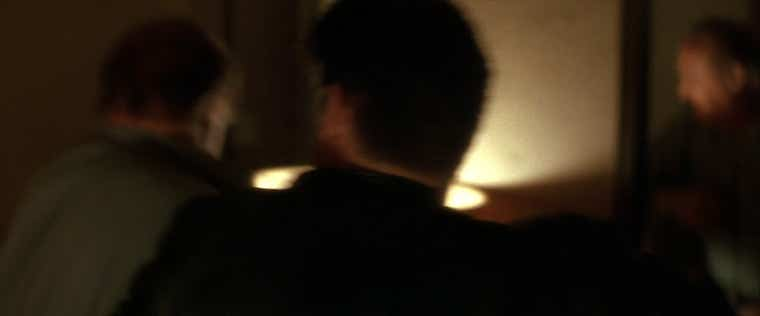
Blink and you’ll miss it. There is a mirror in Room 26 and it is the same mirror that Fred and Pete found earlier in the film.
VEHICULAR MANSLAUGHTER | What do cars mean in Lost Highway?
In Twin Peaks, Lynch uses vehicles as a metaphor for TV shows, certain operators as metaphors for certain viewers (“truck drivers” like crappy TV shows) and the theft of a vehicle representing the theft of artistic control (a truck stolen from a character played by Lynch perennial Jack Nance represents the studio stealing creative control from Lynch)14. Using vehicles to represent films or TV shows is an established Lynchian device.
But first let’s talk about the difference between Fred and Pete. The common wisdom is that Pete is supposed to be the opposite of Fred. Fred is impotent and a murderer; Pete is virile and not a murderer (well, initially). However, the idea that Pete represents innocence is absurd. He’s merely not a murderer. He hangs out with criminals and has a criminal record for stealing a car. Is Pete more virile than Fred? While Pete has lots of great sex, Fred isn’t an old man dreaming he’s a young man. Pete is only eight years younger than Fred. If Pete is supposed to represent an ideal of innocence, why does he live in Van Nuys? Why is his father Gary Busey instead of Hugh Beaumont?
The difference is hearing. Pete has good hearing and Fred does not. Pete is supposedly a mechanic but he and his colleagues appear to be altering the sound of cars and not doing any complicated repairs. Mr. Eddy (Robert Loggia) treasures Pete because Pete makes his Mercedes Benz sound good. “Best god damn ears in town,” says Eddy of Pete. Later, when bugs are crawling around Pete’s room, he is tormented because he can hear every one of them. In the script, Pete is tormented by the sound of his friend’s clunker and there are even more deleted scenes which establish his superhuman hearing.
“Tone Deaf” says police detective Al to Fred, indicating that he could never play tenor sax for a living like Fred does. But he could. Fred’s playing is so jerky and screechy you could easily think that Fred is tone deaf. Fred is all about noise. Pete is all about sound. When Fred’s saxophone solo comes on the radio at the garage, Pete turns it off, disgusted. This is the only time these characters are actually contrasted in a meaningful way.
Now, let’s take a closer look at what kinds of sounds Pete doesn’t like. He can hear the spider and the moths in his bedroom. The spider is a black widow, and a femme fatale character like Alice is often called a Black Widow15. The moths are attracted to the light even though it’s killing them. “Moths to the flame” is a common expression for the dangerous situation that Pete is in—doing something he knows is dangerous because of an irrational attraction to something. Pete, as a stock character, thrives in movies where everything is clear and straightforward and not this metaphorical. Pete can’t stand symbolism. The bug metaphors that take over his bedroom are as repulsive as the sound of a clunker on Ventura Boulevard.
This happens at least one more time, when Andy (Michael Massee) dies. Andy’s head goes through the glass coffee table. I think that Andy, a maker of pornography, also broadly represents consumers of pornography. Not literal pornography, but lowest-common-denominator films that contain exploitative sex and violence. Lynch would probably say that someone like that is metaphorically destroying his mind, so Andy’s mind is literally destroyed. This metaphor is so pronounced that Pete has to flee the room to get a painkiller. Certainly, being an accessory to murder would cause someone anguish, but Pete seems to be having the same pain that he had in his bedroom. He is the antithesis of Lynchian—symbolism repels him.
Pete makes cars sound better which means that Pete makes movies easier to take. The repellant sound of a car in need of repair is what “art films” feel like to the average person. Pete is a lovable, blue-collar cutie, not at all like the tormented, dangerous Fred who likes cacophonous jazz and mopes around his disorienting, expressionist house. Pete is a stock character, the kind of likable and comforting character that you would want as a protagonist, if, say, for example, you’re a third of the way through a film and the esoteric protagonist has done nothing to make the film accessible. Pete should do real American things like go to a bowling alley or go out dancing. Pete goes dancing at a bowling alley.
So, Pete is a character that goes from movie to movie, and if movies are represented by vehicles, then Pete should go from vehicle to vehicle. Here is Pete’s record of vehicle usage:
•Pete is driven home in his parents’ white 1965 Ford Country Squire.
•Pete is driven around town in his friend’s jalopy (deleted).
•Pete is given a ride by Mr. Eddy in his black Mercedes Benz 450 SEL
•Pete drives his black 1967 Plymouth Belvedere to pick up Sheila and have sex with her in the back seat.
•Pete drives his black Harley Davidson to have sex with Sheila in a hotel (I would think that a gentlemen would have offered her a ride).
•Pete takes the bus to Andy’s house.
•Pete drives Andy’s red Ford Mustang to the Lost Highway.
The plot seems to be written to constantly have Pete in a different vehicle and in different types of vehicles. Of course, for Lost Highway fans, one particular trip stands out.
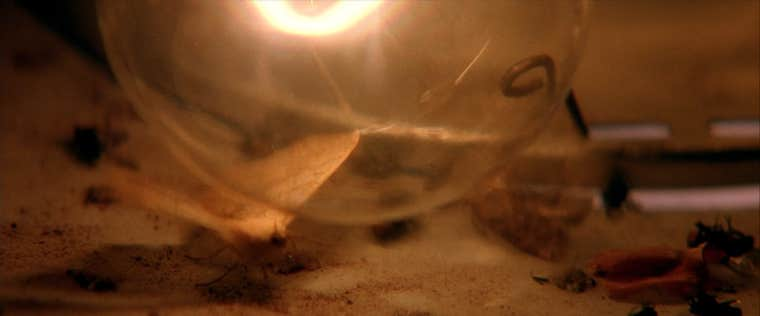
The presence of the dead bugs let’s Pete know that he’s in a David Lynch film.
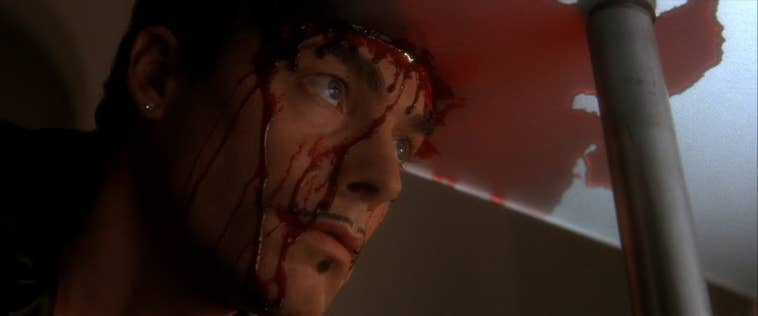
When Pete sees that a character has died from an implausible head injury, he’s certain that he’s in a David Lynch film.
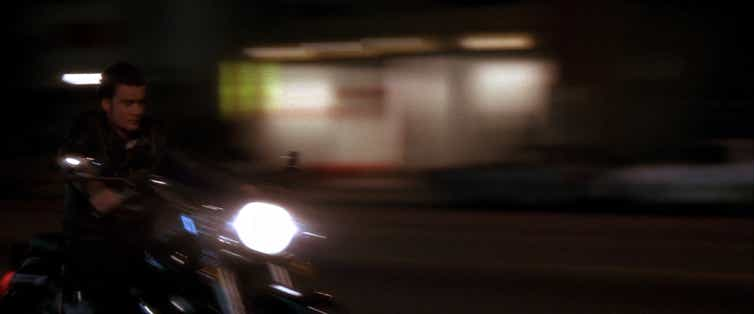
Pete seems to be riding a motorcycle for no reason other than that it’s “next” in the sequence of cool movie vehicles.
MAXIMUM SAFE DISTANCE | what’s up with the Tailgating Scene?
Eddy/Laurent isn't the first person we see who is an enthusiastic fan of Pete’s. Pete’s boss ARNIE (Richard Pryor) says, “It’s good you’re back . . . a lot of people gonna be real happy that you’re back, including me,” and has an almost comical enthusiasm for Pete’s return to the shop (and therefore the return of the character to the movie). The first customer Arnie mentions is not Mr. Eddy but MR. SMITH. Pete has widespread, mainstream appeal—any old Mr. Smith would love Pete. Pete is the textbook protagonist that audiences and filmmakers love.
So, does Mr. Eddy represent a director or directors in general? Sort of. In a film that’s set in L.A., he and Andy are the only characters who are literally filmmakers, but Andy doesn’t seem like the main guy, Laurent/Eddy does. Let’s just think of Mr. Eddy as The Director. He uses a stock character like Pete in his movie which is represented by his Mercedes Benz. And now we can understand the tailgating scene.
Mr. Eddy is very concerned with his car sounding a certain way, purring like a kitten. He is enjoying a drive along Mulholland Drive—the way to Hollywood16. He is going slowly because he is enjoying the experience. A Tailgater (Greg Travis) aggressively approaches him because this driver is in a hurry. He does not want to experience the drive, he wants get to his destination. Mr. Eddy is experiential and the Tailgater is goal-oriented. The tailgater is a film maker who makes movies that are disposable and forgettable.
Can these two co-exist? Can we have cerebral films and popcorn movies? Well, of course we can. Every audience member can do their own thing. Mr. Eddy is conciliatory. With poise and graciousness, he gestures the Tailgater to pass him while keeping an eye on oncoming traffic for his benefit. The scene could end right there, except that the Tailgater makes an obscene gesture. Mr. Eddy crashes into the Tailgater and assaults him.
Mr. Eddy says:
Do you know how many fucking car lengths it takes to stop a car at thirty-five miles an hour? Six fucking car lengths! That’s a hundred and six fucking feet mister! If I had to stop suddenly, you would’ve hit me!
However, 106 is not a multiple of six. The correct number is 108 feet. The average screenplay is 106 pages according to some sources17 and guides to screenwriting suggest this as the maximum length18. As for 35 miles an hour, almost every feature film is shot on 35mm film.
The Tailgating scene is humorous because, while consumed by violent rage, Mr. Eddy lectures the Tailgater on the rules of safe driving. If you took out the profanity, it could be something a mild-mannered driving instructor might say. Mr. Eddy wants filmmakers to do things right. Use stock characters like Pete. Pace your film properly. Do what they teach in film school—those lessons symbolized by the safe driving manual. Anyone who disagrees with his aesthetic can expect a bloody nose.
Now we have a contradiction. Mr. Eddy is experiential and not goal-oriented and that perfectly reflects David Lynch’s philosophy of slow-moving scenes that play on emotions and not hitting story beats. In fact, the reason he left Twin Peaks is because they forced him to reveal the killer, focusing on the goal not the experience, and this destroyed the show. Lynch wanted the viewers to mosey along and enjoy the view, but the network wanted him to hurry up and get to the destination. But does it make sense that Mr. Eddy represents David Lynch?
It is not “Lynchian” to insist a filmmaker obey the rules or to impose his will with violence. He wouldn’t portray himself as a maker of pornography. He wouldn’t portray himself as a violent gangster played by an actor famous for playing aggressive and dangerous men.
He might give a character based on himself his real initials, D.L. (David Lynch = Dick Laurent) and he might have a character based on himself claim to be trying to “out-ugly” competing filmmakers as he often, proudly says that the dark parts of his films are “ugly19.” So what’s going on?
Dick Laurent/Mr. Eddy is what David Lynch looks like to someone who doesn’t like David Lynch. I had suggested that the Mystery Man represents the crew of a film, but it’s bigger than that. He represents filmmakers, critics and the community at large. After the failure of Twin Peaks, Lynch felt like this community had abandoned him. Remember Quentin Tarantino saying that “David Lynch has disappeared up his own ass?” The Mystery Man ultimately kills Dick Laurent. Did Lynch feel this level of betrayal when he started writing Lost Highway? Well, if we assume that the movie is a very exaggerated version of the dark place Lynch was in, then, yes. We’ve all said, “I’m gonna kill that guy,” but it’s expressive not aspirational.
So now the thesis of Lost Highway is coming into focus. Lynch is commenting on other filmmakers who threw him under the bus (another vehicle metaphor). But put a pin in that. We must finish establishing the “rules” of the Lost Highway universe and answer a very important question—why do dead people keep returning to the story?
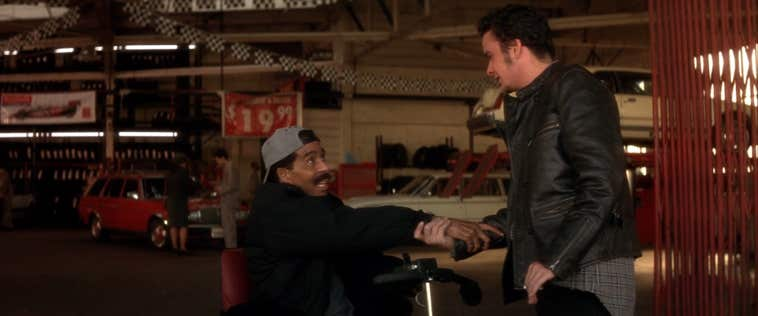
Everyone loves Pete, including his boss, played by an actor—Richard Pryor—who has been in so many well known movies that he may represent a certain segment of Hollywood.
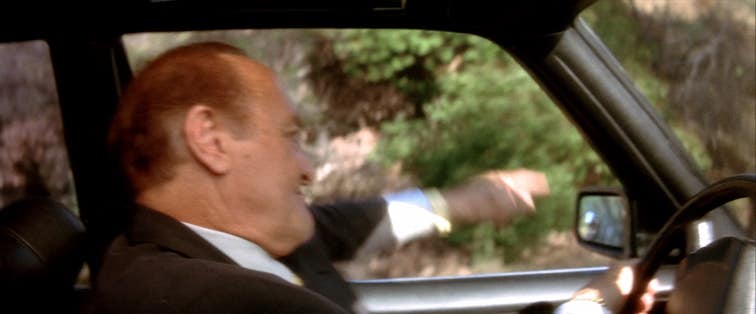
Supposedly a ruthless criminal, Mr. Eddy politely waves the tailgater past him. His violent tendencies and his pleasant demeanor are a purposeful paradox.
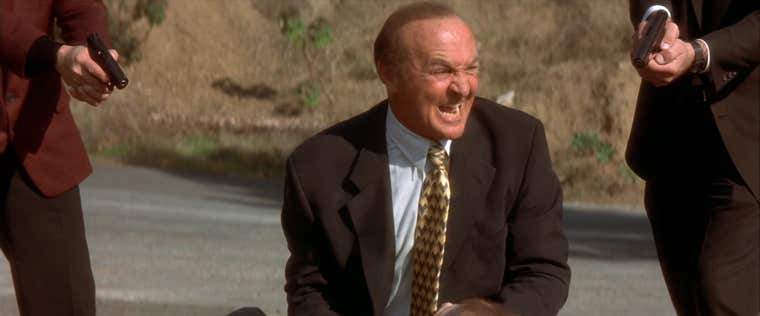
Is Mr. Eddy really the villain here?
Killed Off | Why do dead characters keep returning to the story?
When the first line of the movie is heard: “Dick Laurent is dead,” let’s assume that it is literally true. The only other character who dies in the first act is Renee. There are only two characters who appear in the second act as different characters, the same two characters who have died—Dick Laurent who returns as Mr. Eddy, and Renee Madison who returns as Alice Wakefield. Andy is still Andy, the new cops, Hank and Lou, are completely different characters than Al and Ed. The fact that it’s the dead characters who return with new identities prompts me to think that they are returning from the dead.
To explain this, let me take a hypothetical but more familiar example to explain the dynamic. Let’s say that after the first act, the producers decide that they want Patricia Arquette to stay in the film. They could bring her back as Renee’s twin sister Alice. If they don’t need to explain why the same actress has returned, she could simply be Alice, a new character. Now let’s say that it’s not Patricia Arquette, the actress, but Renee, the character, who wishes to return. She could simply put on a blonde wig and re-enter the diegesis and say, “I'm Alice Wakefield,” and she is functionally resurrected. This is what happened.
If my conjecture about Renee wearing a blonde wig sounds fishy, since Alice is clearly not wearing a wig, remember that if Renee puts on a wig outside of the diegesis it will be real blonde hair inside the diegesis.
As for Mr. Eddy, well, he doesn’t even bother changing his hair or his clothes or anything. Apparently, different movies are all in the same diegesis so characters can cross-over like superheroes in Marvel Comics, and they can return from the dead just as easily. This is why Hank and Lou immediately recognize Mr. Eddy as Dick Laurent as Dick Laurent exists in their world and presumably his activities would attract the attention of the police. There is one police department for all the L.A.-based movies. Maybe Laurent needed a blonde wig as well.
So, we can think of the first act as “The Fred Movie” and the second act as “The Pete Movie.” Just like actors who play a character who dies in one movie can return and play a similar character with a different name in another movie, characters in the Lost Highway universe can die and return as long as there is the minimal amount of pretense that they are different characters in a different story.
Mr. Eddy/Dick Laurent is very similar to Anton Kreutzer, a character also played by Robert Loggia in the Oliver Stone produced mini-series Wild Palms (1993). Kreutzer dies in that movie, but there’s nothing to stop this “Loggian” character from returning in another film20.
This explains why Renee (not Alice) is having sex with Dick Laurent (not Mr. Eddy) in the Lost Highway Hotel. They are outside the diegesis and no longer need to pretend to be someone else. Also, their familiarity implies that the two had been having an affair prior to the first act. At Andy’s party, Renee is worried when Fred mentions Dick Laurent, someone that Fred shouldn’t even know. She is worried that he knows about the affair. It’s possible that she does not even know that Laurent is dead and that she won’t make this discovery until she dies herself.
This also explains why Alice enters the Mystery Man’s house and disappears. Outside the diegesis, you can move from place to place in a manner that would appear to be magic to someone who is a character in a film without any knowledge of the “real” world. Presumably she “warped” to the hotel to make her date with Dick Laurent. When the Mystery Man insists that she is Renee and not Alice, he’s telling the truth.
But I just kind of glossed over Laurent and Alice’s lovemaking. It’s time to explain what sex means in a movie that’s full of it.
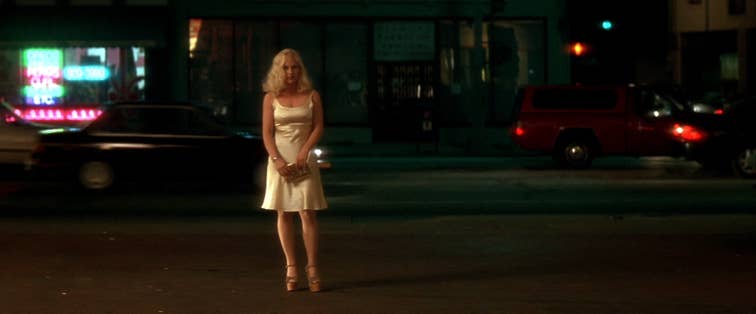
Alice is Renee. She is not the “dream version” of Renee; she is Renee. Note that Renee is French for “reborn.”
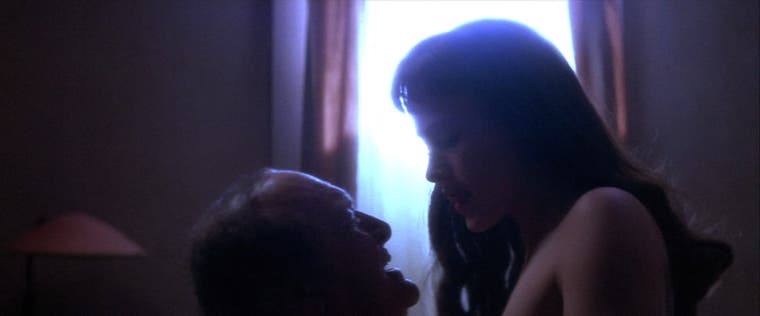
Dick Laurent and Renee Madison—not Mr. Eddy and Alice Wakefield—continue their affair, post-mortem. The characters died, but outside the diegesis, they are as alive as Robert Loggia and Patrica Arquette.
INTERCOURSE BETWEEN TWO WORLDS | What does sex mean in Lost Highway?
If Fred and Pete are protagonists who represent protagonists, then what do their female counterparts represent? Let’s look at the first scene with Fred and Renee—the second scene in the movie. Even though it is a fairly realistic and organic conversation, really it’s just a list of things that Renee finds entertaining.
RENEE: You don't mind that I'm not coming [to see you play saxophone] tonight?
FRED: What are you going to do?
RENEE: I thought I'd stay home and read.
[Fred seems to have a confused almost disoriented look]
FRED: Read?
Renee sits down on a couch and sips her drink. Fred comes over to her, kisses her on the neck, which makes her laugh.
FRED: It’s nice to know I can still make you laugh.
RENEE: I like to laugh, Fred.
FRED: That's why I married you.
RENEE: Wake me up when you get home21.
So, Renee a.) dislikes cacophonous jazz (does not want to see a movie that is noisy and disorienting), b.) likes to read (wants a story, not art school surrealism), c.) enjoys humor (wants a comedy not a dark film) and d.) wants sex, if we assume that “wake me when you get home” is an invitation to sex. She wants a romantic comedy, not a “Lynchian” film. But the two are married, committed, just like someone who likes mainstream films but has come to see Lost Highway has committed to sit there for two hours and fifteen minutes.
Lynch often associates watching a movie with dreaming and associates the relationship between the viewer and the film with sex. Both are done in the bedroom and if you look at Fred and Renee’s bedroom, the metaphor extends to the set design.
There is red curtain that leads into the bedroom and wraps around to the adjacent wall just like the hallway to a theater might have a red curtain and there might be a red curtain to cover the screen, and the window is exactly where the screen would be. Note that the window, which represents a very specific kind of light, is overexposed, only one of two times that something is over-exposed.
The hallway is always dark—conspicuously and excessively dark—throughout the entire movie. When a movie is playing in theater the adjacent hallway is pitch black so the hallway can only be lit when the movie is over, but if the movie is over, none of the sets can possibly be seen, so, the hallway is always dark.
The headboard for the bed has two curves in it, evoking the back of two theater chairs, with pillows where the seat cushions would be. The bedroom is a movie theater. The house is at 7035 Hollis. The two kinds of film used in professional productions are 70mm and 35mm and Hollis could be a shout-out to 1970s surrealist film-maker Hollis Frampton. This convinces me that Fred and Renee’s sex represents the communion between an audience and the filmmaker, and since their sex is bad, we can assume that Fred as a character is not appealing—at least not appealing to the kind of audience represented by Renee.
Now, Pete, on the other hand, is a movie star. His girlfriend Sheila is getting some great sex in Pete’s Plymouth Belvedere. Since people might have sex in a bedroom or a car, the metaphor holds. The classic convertible represents the “Pete Movie.”
Pete’s sex with Alice is equally pleasing for Alice. Or is it? Certainly, it seems that way, but Alice performs in porn. She is an expert at faking sexual pleasure. The porn was shot in a hotel room, which stands in for a studio, where an actor is pretending. That means that every time Alice is having sex in a hotel room, she is faking it, and every time she has sex, it’s in a hotel room, except for her tryst with Pete on the desert floor, but here she clearly rejects Pete. If Alice is really a “black widow” she will try to curry favor with her mark.
The last time we see Pete, he is having sex with Alice in front of the Ford Mustang on the barren desert floor. The headlights from the car illuminate them, evoking the light from a film projector. A film projector makes the image, it doesn’t illuminate something that’s already there, but cause and effect is reversed again. Their bodies are overexposed like Hollywood as seen through the Madisons’ bedroom window which represents a movie screen. We have already established that the Ford Mustang represents the film and the desert exists outside the diegesis, so we are seeing a representation of the film Lost Highway while watching the film Lost Highway.
Alice rejects Pete and leaves. Why? Well, Pete transforms back into Fred as if the adulation of his audience is the only thing that keeps Pete Pete and without it he reverts back to the esoteric and alienating protagonist Fred. This is similar to when a film has a test screening, the audience hates it, and the studio panically makes changes, even drastic changes like replacing the protagonist. Did Alice want Pete to return to being Fred? I think so.
Does Renee always represent the audience for a film. Well, not really. You can also draw parallels to the audience and the protagonist in a Lynch film, and that may explain why, in the final act, Renee is the subject of a film rather than the audience. She performs in Laurent’s creepy porno. She has much more enthusiasm for this role. What does it say about women that Renee prefers to be the participant rather than the observer? I don’t know, and I’m not sure that this is meant to be feminist critique by the filmmakers, however, I must make an observation about Renee’s sex life when she’s an actress rather than a bored housewife.
When we see the actual content of the porn made by Laurent, he and Renee are so excited that they are basically dry-humping. This represents the (subjective) success of the film, wherein Laurent, the filmmaker, and Renee, the subject, have gross sex to symbolize the success in making a gross film. But then Andy stops getting off on looking at the film and starts getting off on watching Laurent and Renee. He has stopped watching the literal film in order to watch the metaphorical film.
The link between sex and violence is clear when we actually see one of Laurent’s films and in the end it features the murder of a cast member, maybe a real murder. This is a reference to a snuff film—an urban legend but frightening nonetheless22. It was assumed that sinister forces would actually murder someone on film and show it to low-lifes with big money on a kind of secret circuit. Just as works of exploitative sex might be called porn, works of exploitative violence might be called a snuff film23.
We feel completely disgusted by this scene, where nameless, presumably privileged individuals watch a morally reprehensible film and the filmmakers are borderline screwing. Andy and Laurent are creepy, but they reach maximum creepiness here. Our emotional reaction trumps the logical reaction to this scene—the fact that it is ridiculous! This is the fever dream of a delusional paranoiac—to think that Lynch is this creepy maker of films with exploitative sex and violence, made for a sinister cabal that, I assume, represents art house devotees. This is Lynch presenting the straw man of himself.
Let’s look at Andy’s sex life. He “pays girls to party with him” which means he pays for sex. For Lynch, prostitution often represents the relationship between a toxic male audience and female characters in distress, or actresses and predatory filmmakers. It’s possible that Andy’s solicitations of women represents both. Just as Andy does not have any meaningful relationships with women, he does not have meaningful relationships with media.
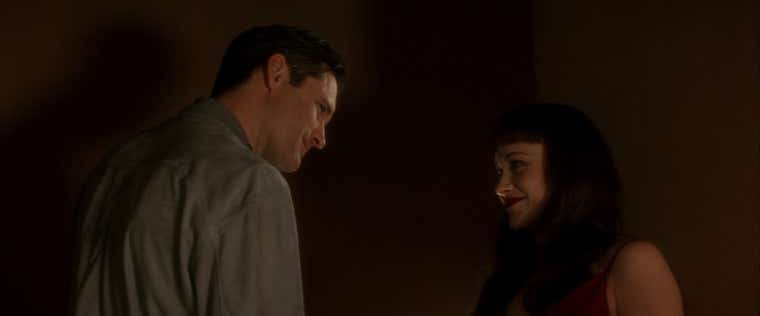
Renee seems to politely smile at Fred who politely smiles back. The awkward, stilted conversation of a married couple whose relationship has grown stale stands-in for a bored audience feigning enthusiasm for a “Lynchian” movie they’d rather leave for the Meg Ryan flick playing in the next theater.
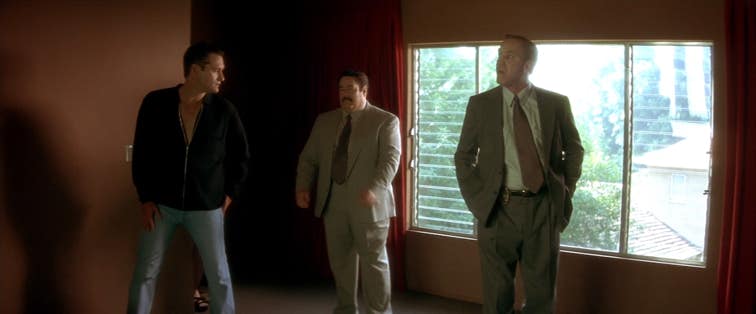
The red curtain and placement of the window evoke a movie screen.
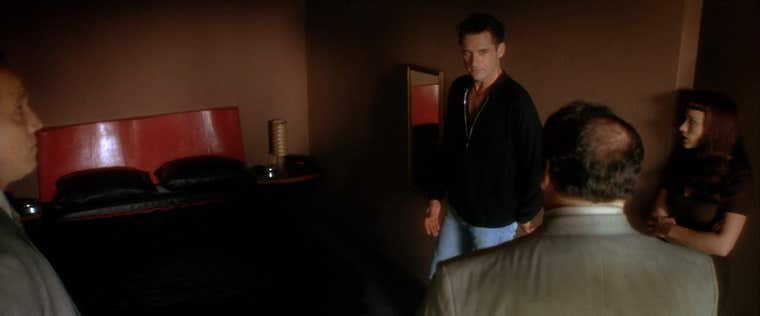
The double curved headboard and the placement of the pillows evoke two theater chairs.
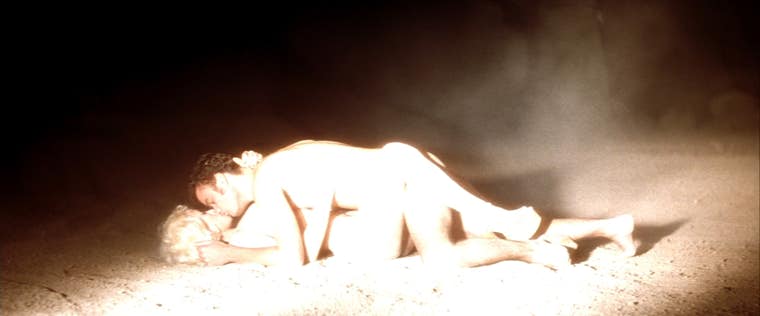
Pete and Alice are illuminated by the cars headlights evoking a film projector creating this image rather than revealing it.
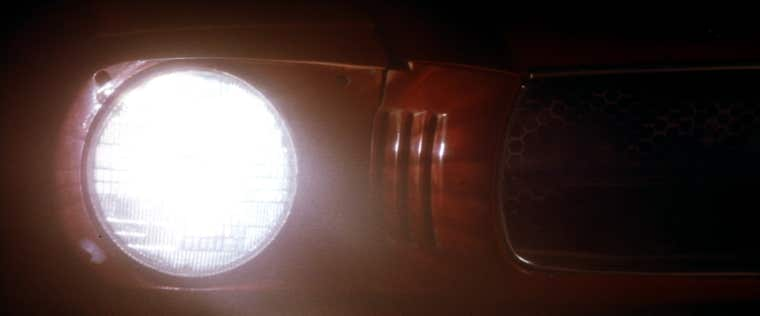
The metaphor of car-as-movie is reinforced by this shot which frames the headlight as the projector bulb.
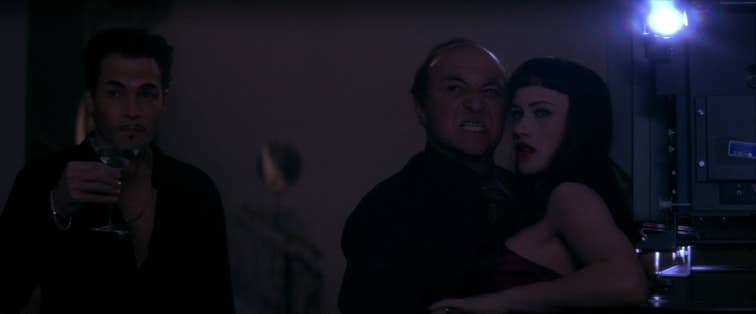
Andy is enjoying a pornographic movie while Laurent and Renee, the director and main character of the movie, respectively, are grinding so hard that they are essentially having sex themselves. This action represents the success of the pornographic film.
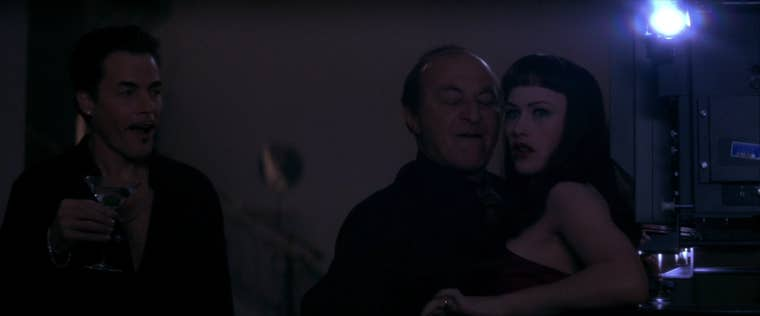
Andy is more interested in watching real sex in front of him rather than a depiction of sex, even though the depiction of sex is real and the real sex is metaphorical.
SEX, LIES AND VIDEOTAPE | Andy Explained
Andy’s pencil thin mustache, which an adult male must carefully groom, recalls the pencil thin mustache an adolescent boy might have without trying. He’s childish, made worse by the adult content of the childish films he devours.
Most viewers of Lost Highway vaguely remember that Pete killed Andy, but that is doubtful. Andy launches himself at Pete with impossible force, and unless Pete did a Judo kick to redirect Andy harmlessly over him, then Andy unintentionally killed himself. Andy literally destroys his brain and the death involves a coffee table, which might be a permanent fixture of one’s TV viewing environment.
Alice’s plan was to steal Andy’s cash, but she never talks about that cash ever again. She steals his valuables, but we never talk about those either. However, Alice does steal his car. In fact, the plan seems to revolve around the outcome of Alice and Pete taking off in that particular car—a red 1965 Ford Mustang. They take this car onto the Lost Highway and this implies that they need this particular car to get onto the Lost Highway. Why does Andy have the magic car?
Let’s talk a look at Andy’s House at 2224 Deep Dell Place. Deep Dell Place is a small road in the Hollywood Hills just south of the Hollywood Sign. Deep Dell Place does not extend far enough east to get to the 2000s, however, where 2224 would be is where the numbers stop going down as you move east and start going up. In other words, 2224 Deep Dell Place is an address that doesn’t exist and can’t exist.
Andy’s House appears to be a “Hollywood Party” in every sense of the words. It looks like the movers and shakers in Show Business are there. Everyone is so immersed in show business that a pale gremlin who broadly symbolizes the community is casually greeted.
Many films use the (circa) 1965 Ford Mustang as a “cool” car24 including Bullitt (1969) and Goldfinger (1964), and there are places in real Hollywood that own and maintain these cars to rent out to productions. Andy apparently has his own 1965 red Ford Mustang, but is it the cool car from the films or is it the cool car from the real world that is used in films to be that car? Oftentimes production cars are owned by people with too much money and not enough brains25. Wanting to own the car from the movie indicates that, in the mind of the wealthy idiot, fantasy and reality have blurred.
The point is that Alice needed to get Pete into that car and I will later argue that this is one plot point of a larger story. But first, there is one last very big plot point to explain . . .
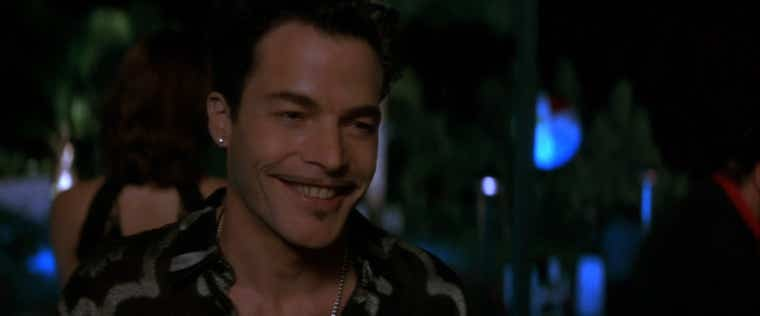
Andy represents the repressed adolescent in arrested development who is childish. He consumes sex and violence even though he is not mature enough to process it. Is it his fault or the fault of exploitative film-makers that his mind is destroyed?
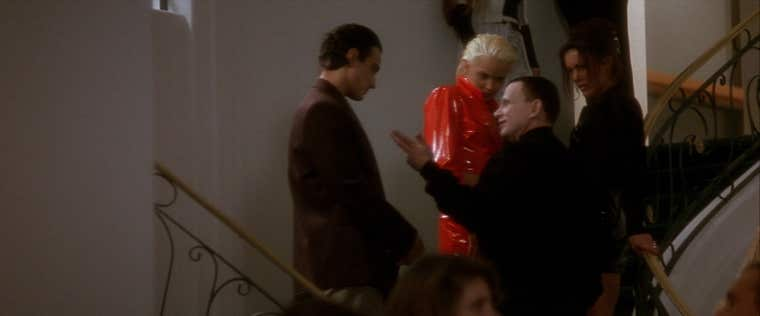
Even though this is one short shot, I think it’s one of the most revealing. The Mystery Man is having a pleasant chat with some show business hipsters. This is one of many reasons I think that he represents the film-making community at large.
THE REAL KILLERS | Did Fred kill Renee?
Did Fred kill Renee? This is such an important question and yet it is rarely considered. We never see the murder and while Fred is troubled does “troubled” translate to “cut his wife into pieces?” We see two seconds of Renee’s cut-up body with blood and guts and a shirtless Fred looking up at the camera, confused, as if someone just dropped him there. Even if we assume that Fred was dispositionally capable of killing his wife, how and why did he carve her up into pieces?
Let’s look at the murder of Renee. Did Fred go get a chainsaw and cut up Renee? Of course not. Note that the cut areas on Renee are where the seams would be if she was a mannequin or a doll. The arms and legs aren’t bending. The lower torso hasn’t collapsed. The severed body parts are rigid as if it was a hard shell filled with blood and guts. In fact, the blood and guts don’t really seem to be “from” the body. It looks like the viscera were just dumped on top of the body parts.
I’m not saying that Renee wasn’t murdered, she was, but since an actress playing a character being murdered would be replaced with a dummy, then Renee looks like a dummy, but she was still murdered. The plastic corpse, that we the audience can recognize as fake, is unquestionably a real body to the characters in the diegesis—especially the police, judge and jury. This is why Fred was convicted.
Notice that we never get a close shot of Renee’s face after her death. If we see her body quickly, we’ll assume it’s her body, if we see her face, we’ll know it’s fake. Humans are extremely adept at recognizing faces. This is why early attempts at CGI faces fell directly into the uncanny valley.
When Fred enters the bedroom, the camera pulls out to reveal a black television screen and it appears that some time has passed. The black television screen indicates to us that missing scenes are genuinely missing. This part of the film doesn’t exist. If the screen was black, that wouldn’t tell us anything because a screen is black when the movie is still running. A TV is black when it is turned off.
When Fred sees the videotape of the murder, it must be an event from the film, since the videotapes are all events from the film. When we see a flash of the murder in clear, color 35mm film, that is how we know that it is “real” in terms of being an event in the diegesis of the film. But is Fred remembering the murder, or is he creating the memory of the murder? That’s just it, the two events are equivalent in Lost Highway.
Am I saying that Fred was framed? Well, look at it this way, if Fred never got the videotape, would he have “remembered” killing Renee? I’d say no. The fact that we cannot connect the image of Fred sitting among the remains to any point in the plot implies that it was manufactured. But why? And by who?
Since the Mystery Man seems to be able to do “magic,” and since he seems to have evil intentions, he is the obvious culprit. But again, why? Does the Mystery Man just torment Fred because he’s a bastard? What does he have to gain?
Let’s go backwards in the story to try to uncover the Mystery Man’s motives. In the end, he kills Dick Laurent. Before that, he had Fred at his front door. Let’s further assume that he needed Fred to help him commit the murder. Prior to Pete transforming back into Fred, Fred is in prison and the Mystery Man opens the curtains to reveal himself. While there is a lot of symbolic value here, on a literal level, the Mystery Man is giving Fred the option of joining him or staying in prison. This means that the Mystery Man has motive to frame Fred for murder so that he can extort Fred’s cooperation for his freedom. In fact, the entire plot of Lost Highway is the story of the Mystery Man planning Dick Laurent’s murder.
But why would the Mystery Man turn Fred into Pete? He didn’t. The two events have different causes. The Mystery Man is planning for Fred to enter the portal and join him, but then the film itself interferes and turns Fred into Pete. This effectively foils the Mystery Man’s plan. The second act of the movie is the Mystery Man revising his plan to deal with Fred’s transformation.
Now, we can actually look at the film in terms of the story.
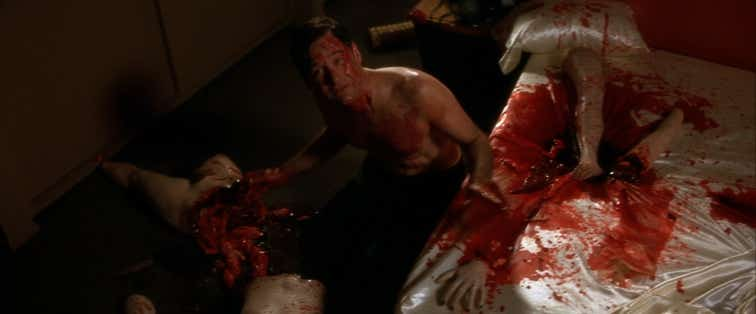
The corpse of Renee appears to be a mannequin. Does this mean that Renee was not murdered? Well, believe it or not, no.
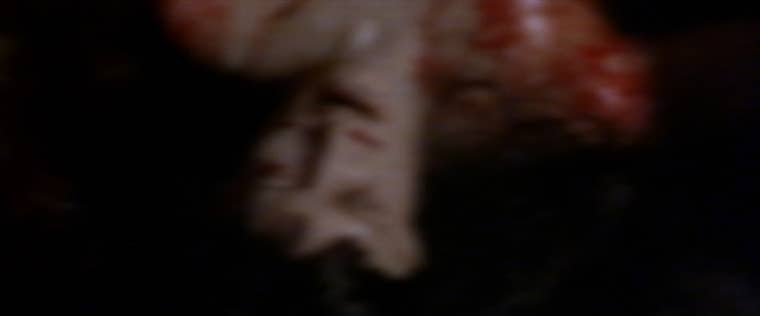
The only close-up of dead Renee’s face is distorted. If it wasn’t distorted, would we see that it’s a plastic head? I think, yes.
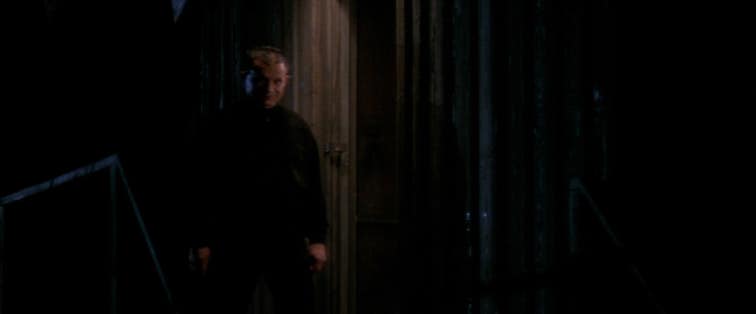
The Mystery Man doesn’t invite Fred into the shack, he appears to Fred and then enters the shack, knowing that Fred will follow him. Once Fred does that, the Mystery Man controls Fred.
“Here I am” | What does the mystery man want?
So, let’s look at the last scene featuring the Mystery Man. The Mystery Man shows Laurent a TV screen, which, according to the rules, is showing Laurent something that actually happened in the film. In fact, the last thing we see in the monitor is the very next shot in the film.
The portable TV shows Laurent proudly premiering the grotesque porn/snuff film. The Mystery Man is essentially putting Laurent on trial and showing that Laurent, who considers himself an artist, relies on exploitative sex and violence. He is merely trying to “out-ugly” his fellow filmmakers. Lynch critics say that Lynch isn’t clever, he just does shocking things and he’s considered a genius.
But note the similarities to the film-within-a-film and the film. There is sex and boobs mixed with eruptions of violence that seem to come out of nowhere. It is disjointed with no apparent story. It is Lost Highway.
The Mystery Man—filmmakers—and Fred—the content of films—have tried Dick Laurent—David Lynch, according to them—and presumably found him guilty and executed him.
But why does the Mystery Man need Fred? And why does the execution have to happen in some random location in the Mojave Desert? Let us continue to work backwards through the story and finally take a look at the scene at the location named after the road after which the film is named.
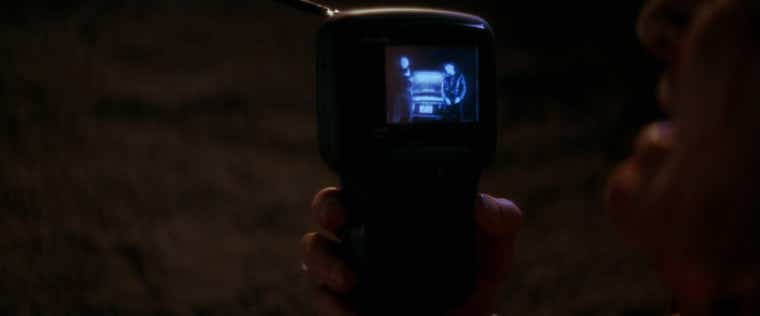
The portable TV shows the Mystery Man reaching for the TV. This is 1996. There is no camera in the device. The TV shows the film that the TV is in.
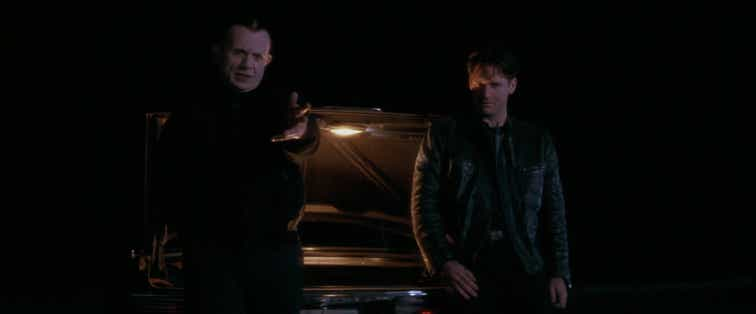
The very next shot is the shot that was in the TV in the previous shot. You can watch the movie Lost Highway while you’re in the movie Lost Highway—self-referentialism to the extreme.
NO-TELL HOTEL | What is up with The Lost Highway Hotel?
Can the Mystery Man just walk up to Laurent anywhere and shoot him? Well, no. Not if Laurent and the Mystery Man exist outside the diegesis. The real consequences of committing murder would exist. To kill Laurent, they need to transport him to a location that is remote in the diegesis and in the real world. Since the Mojave Desert is “backstage” in the Lost Highway universe, and it’s also a remote location in real life, then he would be killed outside the diegesis, meaning he’s really dead—no more returning as Mr. Eddy—and the killers get away.
Can the Mystery Man pistol whip Laurent and toss him in the trunk? No. The only way to do this without leaving any evidence outside the diegesis is to have a fictional character do it. Fred is, apparently, the perfect choice. In fact, the Mystery Man has been manipulating him from the beginning. It seemed that the Mystery Man’s behavior was nebulous, mysterious, as if he merely wanted to torment Fred, but no, he’s been executing a rational plan that, in many ways, is quite brilliant.
When Fred is loading Laurent into the trunk of the car, we pull out to see that the Mystery Man is watching them. Although his face betrays no emotion, he seems unsurprised, like he expected to see this. He is cautiously optimistic. Also, this is the only time we see the Mystery Man by himself and the only time we see him being himself. This, to me, is the key piece of evidence that the murder of Laurent was premeditated and required meticulous planning.
Renee leaves Laurent early just before the abduction. It is likely that Renee is setting up Laurent. Maybe she knows that Fred is right behind her. Renee gets into a car that we’ve never seen before and drives off. Where is she going? We don’t know. She is wearing the same dress she wore at Andy’s party, the only time she ever seemed happy. Does the Mystery Man tempt his confederates with delights or does he exercise de facto telepathic control over them? Maybe half and half? I think that the question is unanswerable. The Mystery Man is a devilish figure, that’s all I can say for sure.
The red Mustang doesn’t have a trunk, so Fred loads Laurent into the trunk of his own Mercedes Benz, which represents the movie that Laurent “stars” in. Only now, instead of being the protagonist, he’s the prisoner. And now we can understand a very mysterious phone call.
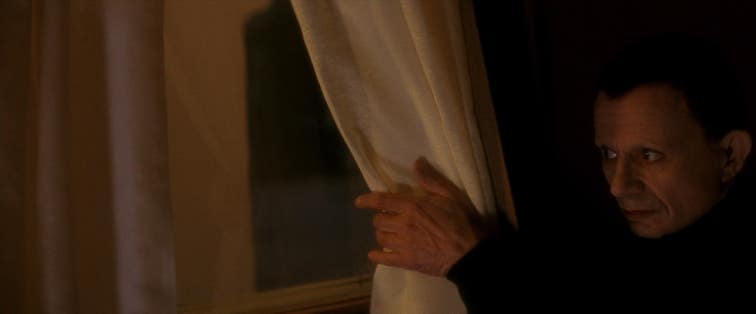
This doesn’t look like someone who is improvising or going with the flow. This looks like someone confirming that things are going according to plan. I think that this is Lynch’s biggest clue that Lost Highway is the story of the Mystery Man’s scheme to kill Dick Laurent.
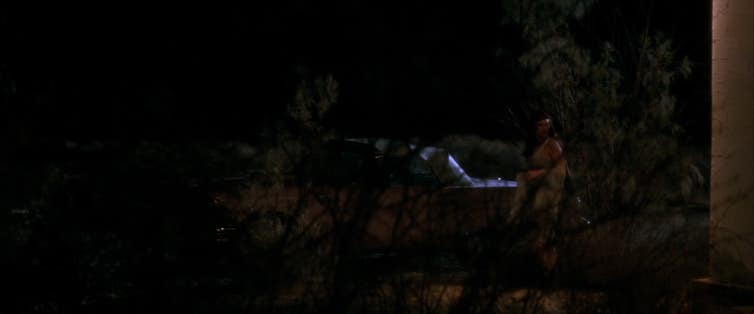
The last time we see Renee, she’s getting into this pink car. What car is this? Is it the red Mustang that appears pink in weird lighting? If yes, is this Renee’s escape plan? We never find out, but it seems like Renee got what she wanted.
REACH OUT AND TOUCH SOMEONE | Why does the Mystery Man deliver a creepy monologue about executions in “The Far East?”
When Fred “returns,” the Mystery Man scares Fred when he pulls out a video camera. Fred actually saw the camera twice, and maybe this is what he saw—a weird guy with a “camera” generally speaking. Fred runs away, but is it because he is afraid of the camera? If he was afraid of the camera, he would just drive off as fast as he can, but he drives to the Lost Highway Hotel and executes the plan. The Mystery Man is not scaring him away, but scaring him into action. But how could Fred know what the plan is?
When Fred turns into Pete, Pete doesn’t seem to have any memories of his life as Fred. However, Pete does not understand of the metaphysics of being a fictional character while Fred does, so I suspect that, when Fred returns, he has all of Pete’s memories, including the memories of the time that Mr. Eddy and the Mystery Man called Pete.
It seems that Laurent and the Mystery Man are just calling to torment Pete. Certainly, Pete doesn’t have any idea what’s happening. But let’s look at the Mystery Man’s monologue:
In the east . . . the far east . . . when a person is sentenced to death . . . they're sent to a place where they can't escape . . . never knowing when an executioner will step up behind them and fire a bullet into the back of their head [ellipses in original].
The Mojave Desert is far east of Los Angeles. "Far” is subjective. Dick Laurent is locked in a trunk and then an executioner shoots him in the head26. The Mystery Man is giving Fred the instructions through Pete.
Why speak in code? Well, he’s standing next to Dick Laurent. He can’t say, “here’s the plan to kill Dick Laurent.” Why not just go to Pete’s house? Maybe he can’t. Since the “Pete Movie” is a straightforward, mainstream movie that doesn’t allow for surrealism, that would stop the Mystery Man from entering since that would be as surreal as it was earlier when the Mystery Man confronted Fred. However, anyone can go anywhere if they call. All they need is for the person in an exclusive part of the diegesis to pick up the phone. In fact, the Mystery Man is, technically, invited into Pete’s house—the only time this event referred to twice in conversation actually happens.
After this, with the help of Alice, Fred is delivered to the Mystery Man’s doorstep. Well, Pete is delivered there. None of the reasons that Alice gives for driving the red Mustang to the shack in the desert makes any sense, so I assume that Alice was making up excuses to get Pete to do as she commanded. When Alice rejects Pete, Pete turns back into Fred.
But why such a complicated plan? Wasn’t there any easier way to get Fred to the shack? Yes, there was: kill Renee.
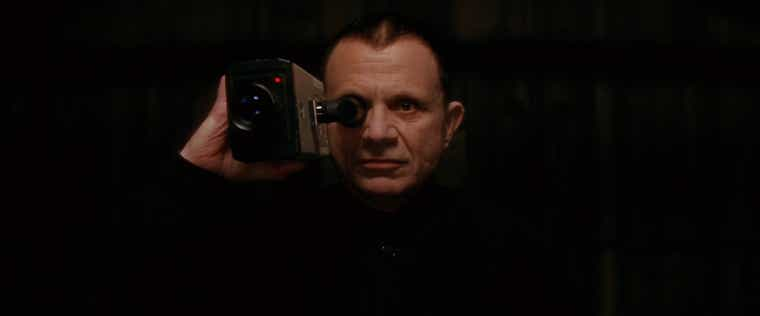
The Mystery Man reveals himself to be the cameraman. Is he chasing Fred or chasing him away?
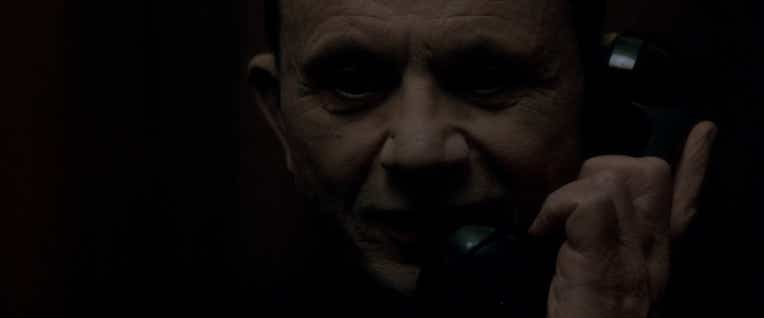
The Mystery Man is calling from his shack outside the diegesis. This implies that he cannot enter the diegesis and act more directly. He is “invited” into Pete’s home when Pete answers the phone.
DAILIES | Why does Fred get creepy videotapes?
The person who says, “Dick Laurent is dead” to Fred is telling him that Dick Laurent—the director of the movie—has died. Fred is free! Perhaps that’s good news, but Fred doesn’t understand the message, so he continues with his business.
Since Mr. Eddy has a history of hanging out with Pete, Dick Laurent must have returned to “life” while the “Fred Movie” is happening. I would speculate that, off-screen, the Mystery Man is kicking himself. He killed Laurent in the diegesis and therefore he did not kill him. The Mystery Man formulates the plan that will eventually be executed and starts the process of getting Fred to understand that he is a character in a movie. The simplest and most effective way to do that is to send Fred a videotape transfer of the movie that Fred is in. The first videotape is a dud. It’s just a shot of the front of the house. Creepy, but not anything that would change one’s worldview.
The second videotape has footage of Fred and Renee. This is also ineffective, and Fred and Renee assume that some psycho broke into the house. When Fred, Renee and the cops exit the house, the camera is high above them, and this is supposed to graphically match the image of the camera above Fred. The shot of Fred and Renee in the bed was supposed to be very high and pointing straight down—a graphic match to the camera on the crane outside the house, and then the camera was supposed to settle into position and shoot the exact image that’s on the first videotape. I don’t know why the shots are done so differently in the actual film, but I must say that what Lynch and Giffords wrote is so brilliant that I’m secretly hoping for a George Lucas “Special Edition.”
With the videotapes failing to convince Fred, the Mystery Man needs to do something drastic and appear in person to Fred. I don’t know if the Mystery Man can appear anywhere in the diegesis, but he can definitely appear in Andy’s House, so perhaps it was a lucky break that Fred and Renee attended a party. Here, the Mystery Man has a simple goal—get Fred to go home. Fred is “supposed” to be at the party all night, so if he goes home early, the home won’t entirely be there. Fred will encounter the truth of his reality.
And so, there you go. The movie is the account of the Mystery Man’s plan to kill Dick Laurent. The Mystery Man wins and the movie is over.
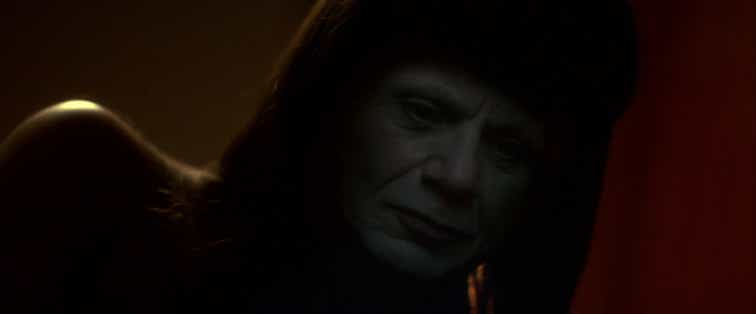
Since Renee represents the audience during this part of the film, an outsider like the Mystery Man can see Fred by looking through her eyes. He discovers Fred, but also gives away his position.
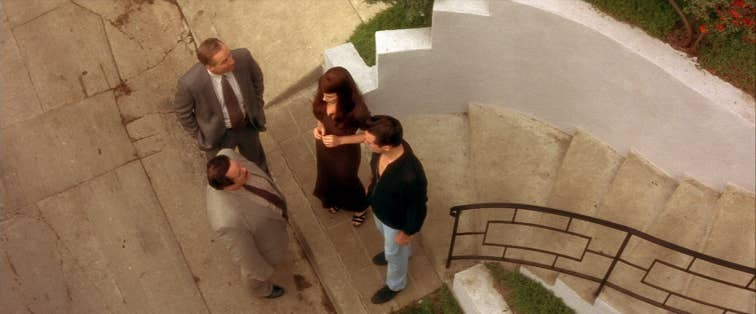
The camera looks straight down on the characters, just like in the videotape. Fred is constantly paranoid about someone above him, looking down, but he’s not completely paranoid. There is a creepy entity looking down on him—the camera.
IT JUST DAWNED ON ME | Why is there a time loop?
But of course, no, that’s not how it ends. For some reason, Lynch give us a long, long take of dawn breaking over the body of Dick Laurent. Why is that? We know that he’s dead and we can assume that eventually the sun will rise. What’s the importance of this shot?
Well, let’s look at the locations outside of the diegesis. They all happen at night. Of course they do, the area outside of a set or location is dark, sometimes pitch black depending on the circumstances. It’s always dark outside the diegesis, just as, on a real film set, the stage is dark with a kind of “bubble” of light where the action takes place. But if dawn is breaking, then we’re in the diegesis. Did the Mystery Man miscalculate?
No. You see, you cannot kill Dick Laurent in real life because Dick Laurent is not a real person. He is a straw man. David Lynch isn’t a violent gangster, he’s an Eagle Scout from Missoula. Dick Laurent’s murder has to be a work of fiction. Therefore, if you kill Dick Laurent, the diegesis will expand to incorporate that event. This symbolizes a failed attempt to make the unreal real. You can’t do it.
Now the narrative is catastrophically damaged. Continuity has been breached. A character who has already been murdered is murdered. Even a movie this bananas cannot allow that.
We know that the movie itself has agency. So, what does the movie do to fix this? It moves the second murder back in time to retroactively be the first murder. Since the first murder was off-screen, this is relatively easy. However, now the timeline has been twisted into a loop. Additionally, the timeline is not entirely metaphorical. The physical celluloid is a literal timeline of the film, and it can be twisted.
There is an overlap between the first few minutes and the last few minutes of the movie. If you line up the beginning and end of the movie, and adjust the time so that the line “Dick Laurent is dead” takes the same amount of time, this happens:
•The sun rises over Dick Laurent as the sun rises over Fred—the “creation” of Fred.
•The sound of tires screeching and police sirens blaring are synchronized.
•The camera pan is synchronized.
•Fred is annihilated in the end and then immediately walks out of the darkness in the beginning.
In spite of Fred’s apparent immolation, it is the Mystery Man who is the loser. He is doomed to repeat the same failed plan over and over again. Who’s the winner? David Lynch. He exists outside the diegesis, in terms of the “rules” of the movie, and in real life. These creeps who are trying to bring him down are just repeating the same useless actions over and over again. They are spinning their wheels.
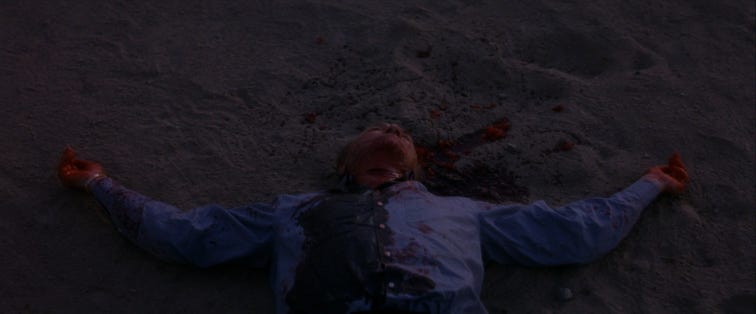
Dawn creeps over the body of Laurent. This is the diegesis expanding to include the murder of Laurent among the category of all things fictional.
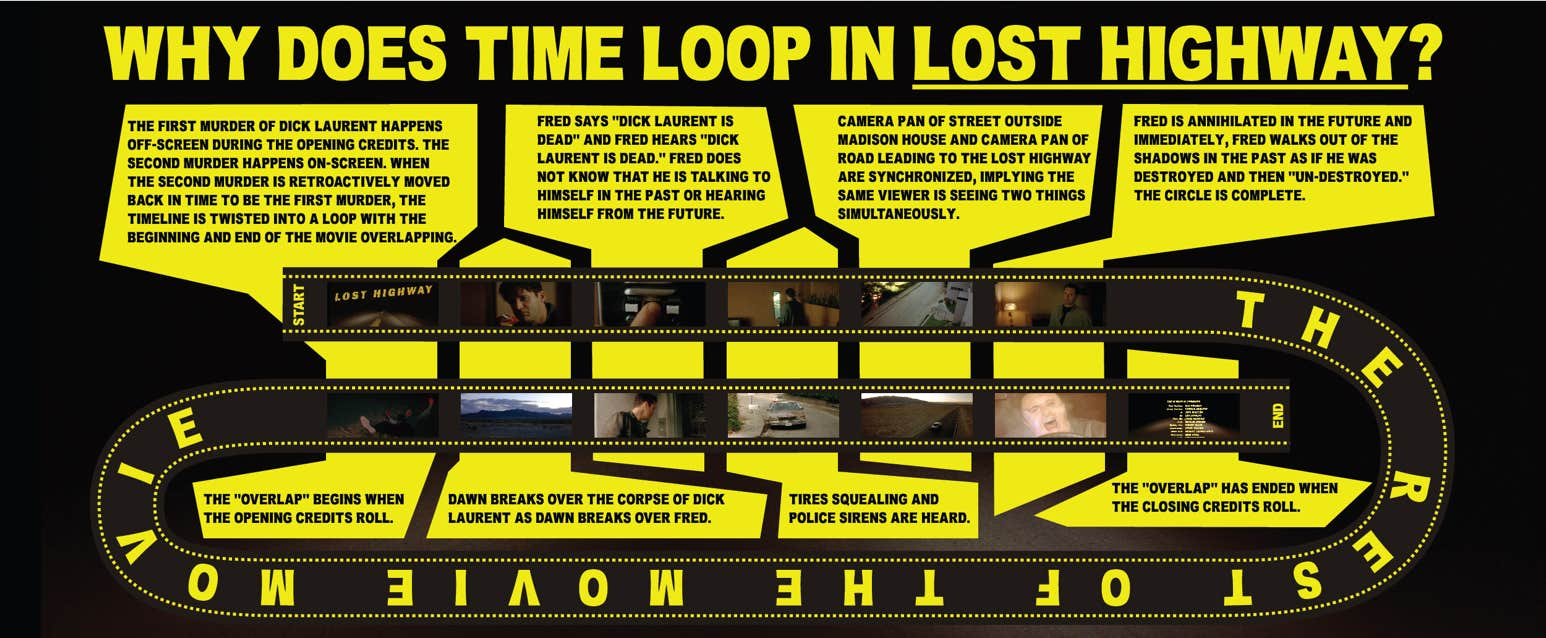
Conclusion | What is Lynch trying to say?
Lynch has said that Lost Highway comes out of a “dark place.” I interpret that as Lynch feeling wronged. This is the breeding ground for the film.
The idea that the characters of a film would be used as tools for agents outside the diegesis to do destructive things is not so abstract. After Lynch left Twin Peaks, the remaining staff took the show in a very different direction and viewers had to watch these characters they love become something else and do uninteresting things for fourteen episodes. When he didn’t get final cut on Dune, the film was different than what he had wanted, so for him, it must have been as if the characters were obeying an unseen sinister force. This idea is encapsulated in Fred Madison.
His films are criticized for being misogynist, homophobic, too violent, or in some way supporting a toxic world view27, but, to Lynch, these criticisms are made by people who don’t understand his films, so it’s like they are criticizing some other, non-existent person—a straw man. This is Dick Laurent. When Laurent is dry-humping Renee this must be what Lynch-detractors are thinking of when he’s working with all these beautiful young women and getting close with them. Being accused of something he didn’t do is mirrored in Fred being framed for murder.
Just like the Mystery Man and Fred presenting “evidence” of Laurent’s guilt and the off-screen, formal trial of Fred, Lynch has been railroaded. The Mystery Man is unambiguously a friend of Dick Laurent and Fred and Laurent were pals by proxy in the form of Pete and Mr. Eddy. Al and Ed were friends with Fred until they brutalized him. Everyone gets stabbed in the back, and I believe that Lynch perceives himself like that.
So, Lost Highway is a dark story about dark time and it has a dark ending. However, Jeffrey Williams has a surprisingly positive spin: “Everyone gets stabbed in the back but what’s important is how you creatively and artistically rise above that.” I guess you can think of Lost Highway as Lynch’s way of making something good out of bad circumstances. That’s what an Eagle Scout from Missoula would do.
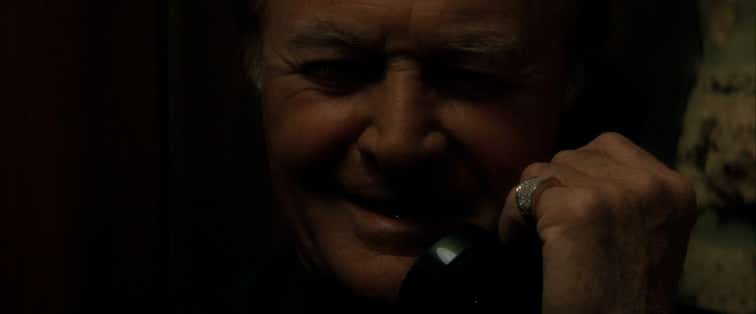
“I want you to talk to a friend of mine.”
1 Lynch, David. Catching the Big Fish: Meditation, Consciousness, and Creativity. Page 109.
2 ibid
3 CPF Reviews #5: The Long and Winding Road-An Analysis of "Lost Highway.” YouTube. June 7, 2017.
5 David Lynch's Lost Highway as a commentary on other directors.
6 See reports of this HERE, HERE and HERE.
8 Lost Highway: Further Exits.
13 This tracks with Lynch’s style as the “Great Northern” Hotel in Twin Peaks is supposed to represent the studio that is making the real show, Twin Peaks. This has been covered in Rosseter’s YouTube video and in my past essays on Twin Peaks and will be covered more in my future essays on Twin Peaks.
14 This idea was introduced in Rosseter’s video here and elaborated upon in my essay here.
15 Thanks to Matt Murray for pointing this out.
16 Yes, there other, real roads that get you to Hollywood, but Rosseter makes the case that Mulholland Drive is the way to Hollywood in that it represents the entire journey of going to Hollywood, thus Diane’s (Naomi Watts) terrifying descent into madness is a film called “Mulholland Drive.”
17 HERE and HERE. Another, updated source says that the average action screenplay is 106 pages.
20 In Wild Palms, Kreutzer dies in a very ambiguous way, essentially vanishing after achieving his evil plan of transcending the physical plane. Is Lost Highway the next plane of existence in some metaphysical cinematic universe? It’s not out of the question.
23 Ironically, Barry Giffords referred to Blue Velvet as a snuff film.
24 The Internet Movie Database was kind enough to do some of my research for me.
25 This was an important plot point in the crime satire The Tower Heist (2011) in which a Bernie Madoff figure played by Alan Alda owned Steve McQueen’s red Ferrari.
26 Yes, the Mystery Man shoots him in the front of the head, not the back. I have no explanation for this, but I don’t think that a single preposition dispels my theory.


